New England Contents History Geography Demographics Cities and urban areas Economy Government Education Culture Sports Transportation See also Notes References Further reading External links Navigation menu"Resident Population in the New England Census Division""Yankee""Gross domestic product (GDP) by state (millions of current dollars)""Columbia Electronic Encyclopedia""Britannica article""American Heritage Dictionary""Random House Unabridged Dictionary""Merriam-Webster Dictionary"Archived copy"The 1692 Salem Witch Trials"Asian Americans in New England: Culture and Community"Abenaki History"The History of Norridgewock"The Voice of the Dawn: An Autohistory of the Abenaki Nation""What are the oldest cities in America?"the originalBritannica.comArchivedSigners of the Mayflower Compact, vol. 1Our Constitution: How and Why It Was Made"Public Records: The History of the Arms and Great Seal of the Commonwealth of Massachusetts"The Bay Colony: A Civil, Religious and Social History of the Massachusetts Colony"History of Boston, Massachusetts""About Connecticut"the original"Roger Williams—A Historiographical Essay""History & Famous Rhode Islanders"The History of Vermont: From Its Discovery to Its Admission into the Union"1637 - The Pequot War"The Puritan Republic of the Massachusetts Bay in New England"1675 - King Philip's War""The New England Flag"the original"Flags of the Early North American Colonies and Explorers"Flag: An American BiographyProceedings of the First New England Conference: Called by the Governors of the New England States, Boston, Nov. 23, 24, 1908History of the Flag of the United States of America: And of the Naval and Yacht-club Signals, Seals, and Arms, and Principal National Songs of the United States, with a Chronicle of the Symbols, Standards, Banners, and Flags of Ancient and Modern Nations"The Dominion of New England"History of New England, vol. 3A Compendious History of New England, vol. 3"Slavery in New Hampshire""Yankeeland""Missouri Compromise: Primary Documents of American History"History of the Hartford ConventionAmerican Politics (Non-Partisan) from the Beginning to Date, Book IIIA History of American LiteratureArchived copy"History & Culture: Birthplace of the American Industrial Revolution""Forging Arms for the Nation""The Springfield Armory: The Heartbeat of the 19th Century Industrial Revolution""The Industrial Revolution: Connecticut River Valley Overview"the original"Census Data for Year 1850"the original"American Abolitionism and Religion"Elections A to Z"The Crompton Closing: Imports and the Decline of America's Oldest Textile Company""Poverty: 1999""Income in the Past 12 Months (in 2014 Inflation-Adjusted Dollars): 2014 American Community Survey 1-Year Estimates (S1901)""Part 1: Population and Housing Unit Counts""The British Isles and all that ...""Glacial Features of the Exotic Terrane"The Geography of New England"Physiographic divisions of the conterminous U.S.""Topography of the Appalachian/Piedmont Region 2""The 10 Tallest Mountains East of the Mississippi""World Record Wind""World Record Wind Gust: 408 km/h"the original"About Us""Wolfe turns love of books into career; One-hundredth anniversary of library in Troy approaching"the original"New England's Fall Foliage"the original"New England Population: 2010 Census""Population Estimates""Births: Final Data for 2008""Hispanic or Latino Origin by Specific Origin: 2014 American Community Survey 1-Year Estimates: New England Division (B03001)""People Reporting Ancestry: 2014 American Community Survey 1-Year Estimates: New England Division (B04006)""Most Common Languages Besides English In The US & New England""Language Spoken at Home: 2014 American Community Survey 1-Year Estimates: New England Division (S1601)""Language Spoken at Home by Ability to Speak English for the Population 5 Years and Over: 2014 American Community Survey 1-Year Estimates: New England Division (B16001)""Selected Characteristics of the Native and Foreign-Born Populations: 2014 American Community Survey 1-Year Estimates: New England Division (S0501)""Place of Birth for the Foreign-Born Population in the United States: 2014 American Community Survey 1-Year Estimates: New England Division (B05006)""Annual Estimates of the Resident Population: April 1, 2010 to July 1, 2015 - United States -- Metropolitan and Micropolitan Statistical Area: 2015 Population Estimates (GCT-PEPANNRES)""Annual Estimates of the Resident Population: April 1, 2010 to July 1, 2015 - United States -- Combined Statistical Area: 2015 Population Estimates (GCT-PEPANNRES)""Annual Estimates of the Resident Population for Incorporated Places: April 1, 2010 to July 1, 2014"the original"TIGERweb""Background on the New England Economy"the original"Regional Data: GDP & Personal Income""The Global Financial Centres Index 21"the original"The Global Financial Centres Index 9"the original"Top 10 Cities For A Career In Finance""History of Boston's Economy – Growth and Transition 1970–1998"the original"General Electric To Move Corporate Headquarters To Boston""Top shoe brands, like Reebok and Converse, move headquarters to Boston""Reebok Is Moving to Boston""Connecticut Has 19 Companies On Fortune 500 List""Maine State Agriculture Overview - 2004"the original"Vermont State Agriculture Overview - 2006"the original"Connecticut State Agriculture Overview - 2005"the original"Massachusetts State Agriculture Overview - 2005"the original"State Energy Profiles: State Rankings - State Ranking 7. Total Energy Consumed per Capita, 2013 (million Btu)""State Energy Profiles: State Rankings - State Ranking 9. Average Retail Price of Electricity to Residential Sector, December 2015 (cents/kWh)""National Conference of State Legislatures State Unemployment Rates 2015""Unemployment Rates for States""New England — Labor Force Statistics""2018's Tax Burden by State"Ilsr.orgArchive indexDemocraciaparticipativa.netArchived"New England USA Quick Facts"the original"Wyoming, Mississippi, Utah Rank as Most Conservative States""Sanders Socialist Successes""AIG: Where's the outrage?""Election Center 2008""A Laboratory for Liberals?""New England grapples with first execution"the original"Gregg cites states' rights in voting against amendment""Massachusetts, Maryland Most Democratic States"The Concise Princeton Encyclopedia of American Political History"No More 'New England Republicans'""Mike Huckabee: Mike Huckabee's Weekly Schedule for Sept. 24"the original"Prepping for a party""Boston Latin School"Life in Civil War America"FRBB: New England Economic Review"New England's Crises and Cultural MemoryAlbion's Seed: Four British Folkways in America"New England Population History"the original"State of the States: Importance of Religion""ARIS 2008 Report: Part IIIC – Geography and Religion"History of the American Whale Fishery from its Earliest Inception to the Year 1876"Common Traits of the Boston Accent"How We Talk: American Regional English Today"Guide to Rhode Island Language Stuff""New England's best ice cream"the original"Surviving the New England Winter: You Scream, I Scream, Ice Cream!""History of Candlepin Bowling"the originalBoston.comArchived"Boston.com""Older Than the Nation""What's So Funny?""Destination: New England""A History of Boston Films""New England in Feature Films""Hollywood on the Charles: Why the movie industry is crazy for Boston"the original"History of Basketball""History of Volleyball""Ohio Tiger Trap"the original"Haverhill chamber chief supports train stop in Plaistow"the original"Plaistow officials hopeful MBTA considers rail extension"the original""Census Regions and Divisions of the United States""the originalNew England Governors ConferenceHistoric New EnglandMinuteman National Park HomepageHistoric USGS Maps of New England & NYMap of New EnglandNew England Music Archive44°N 71°W / 44°N 71°W / 44; -71eeeeeeeeeeeecb139458053(data)4075306-2sh8509126010045837236811278236811278
Guinea regionGulf of GuineaCape LopezMayombeIgbolandMbaiseMaputalandPool MaleboCongo BasinChad BasinCongolese rainforestsOuaddaï highlandsEnnedi PlateauMaghrebIfriqiyaBarbary CoastBashmurAncient LibyaAtlas MountainsNile ValleyNile DeltaCataracts of the NileDarfurGulf of AqabaLower EgyptLower NubiaMiddle EgyptNile DeltaNuba MountainsNubiaThe SudansUpper EgyptWestern SaharaMadagascarCentral Highlands (Madagascar)Northern HighlandsRhodesiaNorthSouthThembulandSucculent KarooNama KarooBushveldHighveldFynbosCape Floristic RegionKalahari DesertOkavango DeltaCape PeninsulaFalse BayHydra BayGreater Middle EastAral SeaAralkum DesertCaspian SeaDead SeaSea of GalileeTartaryTransoxianaTuranGreater KhorasanArianaKhwarazmSistanKazakhstaniaKazakh SteppeBetpak-DalaEurasian SteppeAsian SteppeKazakh SteppePontic–Caspian steppeMongolian-Manchurian grasslandWild FieldsYedisanMuravsky TrailUralUral MountainsVolga regionIdel-UralKolymaTransbaikalPryazoviaBjarmalandKubanZalesyeIngriaNovorossiyaGornaya ShoriyaTulgasIranian PlateauAltai MountainsPamir MountainsTian ShanBadakhshanWakhan CorridorWakhjir PassMount ImeonMongolian PlateauWestern RegionsTaklamakan DesertKarakoramTrans-Karakoram TractSiachen GlacierOrientJapanese archipelagoNortheastern Japan ArcSakhalin Island ArcKorean PeninsulaGobi DesertTaklamakan DesertGreater KhinganMongolian PlateauInner AsiaInner MongoliaOuter MongoliaChina properManchuriaOuter ManchuriaInner ManchuriaNortheast China PlainMongolian-Manchurian grasslandNorth China PlainYan MountainsKunlun MountainsLiaodong PeninsulaHimalayasTibetan PlateauTibetTarim BasinSichuan BasinNorthern Silk RoadHexi CorridorNanzhongLingnanLiangguangJiangnanJianghuaiGuanzhongHuizhouWuJiaozhouZhongyuanShaannanOrdos LoopLoess PlateauShaanbeiHamgyong MountainsCentral Mountain RangeJapanese AlpsSuzuka MountainsLeizhou PeninsulaGulf of TonkinYangtze RiverYangtze River DeltaYellow RiverPearl River DeltaYenisei BasinAltai MountainsWakhan CorridorWakhjir PassOrientGreater IndiaIndian subcontinentHimalayasHindu KushBactriaCarnatic regionWestern GhatsEastern GhatsGanges BasinGanges DeltaPashtunistanPunjabBalochistanKashmirKashmir ValleyPir Panjal RangeThar DesertIndus ValleyIndus River DeltaIndus Valley DesertIndo-Gangetic PlainEastern Coastal PlainsWestern Coastal PlainsMeghalaya subtropical forestsMENASALower Gangetic plains moist deciduous forestsNorthwestern Himalayan alpine shrub and meadowsDoabBagar tractGreat Rann of KutchLittle Rann of KutchDeccan PlateauCoromandel CoastKonkanFalse Divi PointHindi BeltLadakhAksai ChinGilgit-BaltistanBaltistanShigar ValleyKarakoramSaltoro MountainsSiachen GlacierBay of BengalGulf of KhambhatGulf of KutchGulf of MannarTrans-Karakoram TractWakhan CorridorWakhjir PassLakshadweepParopamisadaeAndaman and Nicobar IslandsAndaman IslandsNicobar IslandsMaldive IslandsAlpide beltAsia-PacificTropical AsiaRing of FireNordicNorthwesternScandinaviaScandinavian PeninsulaFennoscandiaBaltoscandiaJutlandSápmiWest NordicBalticBaltic SeaGulf of BothniaGulf of FinlandIcelandFaroe IslandsBritish IslesBalticBaltic SeaAlpine statesAlpide beltVisegrád GroupRhinelandEastphaliaPrussiaBohemiaMoraviaSilesiaCzech SilesiaPomeraniaPomereliaKashubiaBukovinaIstriaItalian PeninsulaPo ValleyPadaniaInsular ItalyTuscan ArchipelagoAegadian IslandsIberiaAl-AndalusBaetic SystemGibraltar ArcSoutheasternMediterraneanAlpide beltEastern CanadaWestern CanadaCanadian PrairiesCentral CanadaNorthern CanadaAtlantic CanadaThe MaritimesFrench CanadaEnglish CanadaAcadiaAcadian PeninsulaQuebec City–Windsor CorridorPeace River CountryCypress HillsPalliser's TriangleCanadian ShieldInterior Alaska-Yukon lowland taigaAleutian ArcAleutian RangeAlaska PeninsulaAleutian IslandsGulf of AlaskaKodiak IslandNewfoundland (island)Vancouver IslandGulf IslandsStrait of GeorgiaCanadian Arctic ArchipelagoLabrador PeninsulaGaspé PeninsulaAvalon PeninsulaBay de Verde PeninsulaBrodeur PeninsulaMelville PeninsulaBruce PeninsulaBanks Peninsula (Nunavut)Cook PeninsulaGulf of BoothiaGeorgian BayHudson BayJames BayGreenlandPacific NorthwestInland NorthwestNortheastNew EnglandMid-AtlanticCommonwealthPacific Coast RangesWestMidwestUpper MidwestMountain statesIntermountain WestBasin and Range ProvinceOregon TrailMormon CorridorCalumet RegionSouthwestOld SouthwestLlano EstacadoCentral United StatesTallgrass prairieSouthSouth CentralDeep SouthUpland SouthSanta Fe de Nuevo MéxicoFour CornersEast CoastWest CoastGulf CoastThird CoastEastern United StatesAppalachiaBackcountryTrans-MississippiGreat North WoodsGreat PlainsInterior PlainsGreat LakesGreat BasinGreat Basin DesertAcadiaOzarksArk-La-TexWaxhawsSiouxlandTwin TiersDriftless AreaPalousePiedmontAtlantic coastal plainOuter LandsBlack Dirt RegionBlackstone ValleyPiney WoodsRocky MountainsMojave DesertThe DakotasThe CarolinasShawnee HillsSan Fernando ValleyTornado AlleyNorth CoastLost CoastEmerald TriangleSan Francisco Bay AreaSan Francisco BayNorth BayEast BaySilicon ValleyInterior Alaska-Yukon lowland taigaGulf of MexicoLower Colorado River ValleySacramento–San Joaquin River DeltaYukon–Kuskokwim DeltaColville DeltaArkansas DeltaMobile–Tensaw River DeltaMississippi DeltaMississippi River DeltaColumbia River EstuaryGreat BasinHigh DesertMonterey PeninsulaUpper Peninsula of MichiganLower Peninsula of MichiganVirginia PeninsulaKeweenaw PeninsulaMiddle PeninsulaDelmarva PeninsulaAlaska PeninsulaKenai PeninsulaNiagara PeninsulaBeringiaBelt regionsBible BeltBlack BeltCorn BeltCotton BeltFrost BeltRice BeltRust BeltSun BeltSnow BeltAridoamericaMesoamericaOasisamericaNorthernMiddleAngloLatinFrenchHispanicAmerican CordilleraRing of FireLACGulf of CarpentariaZealandiaKula GulfAustraliaCapital CountryEastern AustraliaLake Eyre basinMurray–Darling basinNorthern AustraliaNullarbor PlainOutbackSouthern AustraliaMaralingaSunraysiaGreat Victoria DesertGulf of CarpentariaGulf St VincentLefevre PeninsulaFleurieu PeninsulaYorke PeninsulaEyre PeninsulaMornington PeninsulaBellarine PeninsulaMount Henry PeninsulaCaroline IslandsFederated States of MicronesiaPalauKiribatiMariana IslandsGuamNorthern Mariana IslandsMarshall IslandsNauruWake IslandRing of FireAmazon basinAtlantic ForestCaatingaCerradoTierra del FuegoPatagoniaPampasPantanalGran ChacoChiquitano dry forestsValdes PeninsulaTriple FrontierLatinHispanicBolivarianAmerican CordilleraRing of FireLACAntarctic PeninsulaEast AntarcticaWest AntarcticaEklund IslandsEcozoneExtreme pointsIslands
English colonization of the AmericasNew EnglandCensus regions of the United StatesMilitary history of New EnglandHistory of New EnglandRegions of the United States
MaineVermontNew HampshireMassachusettsRhode IslandConnecticutNew YorkNew BrunswickQuebecLong Island SoundGreater BostonWorcester, MassachusettsManchester, New HampshireProvidence, Rhode IslandPuritan Separatist PilgrimsPlymouth ColonyJamestown SettlementMassachusetts Bay ColonyFrench and Indian WarsIroquoisAlgonquianSalem, MassachusettsSalem witch trialstaxes without the consent of the colonistscaptured and burned a British shipthrew British teaIntolerable ActsAmerican Revolutionary WarIndustrial RevolutionBlackstoneMerrimackcoastal plainfall lineConnecticut RiverEastern Algonquian languagesAbenakisMi'kmaqPenobscotPequotsMohegansNarragansettsPocumtucksWampanoagNorridgewockPenobscot RiverBlock IslandMartha's VineyardNantucketConnecticut River ValleyJames I of EnglandVirginia CompanyLondon CompanyPlymouth CompanyPlymouth ColonyJohn SmithPlymouth Council for New EnglandMayflower CompactMassachusetts Bay ColonyRoger WilliamsProvidence PlantationColony of Rhode Island and Providence PlantationsPequot WarMystic massacreNew HavenNew England ConfederationKing Philip's WarNew FranceIroquois ConfederacyWabanaki ConfederacySiege of Port Royal (1710)Puritan work ethicKing James IINavigation ActsDominion of New EnglandNew YorkEast New JerseyWest New JerseyGlorious RevolutionSir Edmund AndrosChurch of Englandpopular and bloodless uprisingAmerican RevolutionWar of American IndependenceLexington and Concord, MassachusettsSiege of BostonMissouri CompromiseBritish EmpireWar of 1812FederalistsHartford ConventionConstitutionsecessionFederalist PartyWhig PartySecond Party SystemDemocraticDaniel WebsterRalph Waldo EmersonHenry David ThoreauNathaniel HawthorneHenry Wadsworth LongfellowJohn Greenleaf WhittierGeorge BancroftWilliam H. Prescottindustrial revolutionBlackstone ValleyNorth ShoreBeverly, MassachusettsBeverly Cotton ManufactorySlater MillPawtucket, Rhode IslandLawrence, MassachusettsLowell, MassachusettsWoonsocket, Rhode IslandLewiston, MaineConnecticut River ValleySpringfield Armoryinterchangeable partsassembly lineSpringfield, MassachusettsHartford, Connecticutadvanced manufacturingLowell Mill GirlsIrishFrench CanadiansWestern ReserveMichiganWisconsinGreat AwakeningWilliam Lloyd GarrisonJohn Greenleaf WhittierWendell PhillipsJohn Quincy AdamsCharles SumnerJohn P. HaleRepublican PartySouthern strategyconsistently Democratic strongholdWorld War IGreat Depression in the United StatesNew Deal coalitionWorld War IIRust BeltProvidence, Rhode IslandHartford, Connecticutstate of WashingtonIndianasmallest stateglacial landformslast glacial periodNew England provinceexotic terraneAppalachian MountainsThe BerkshiresGreen MountainsTaconic MountainsPrecambrianWhite MountainsMount Washingtonhighest recorded wind speedConnecticut River ValleyMerrimack ValleyConnecticut RiverLong Island SoundLake ChamplainMoosehead LakeLake Winnipesaukeehumid continentalKöppen climate classificationcontinental climatessubtropicalAmerican Community SurveyWhite AmericansHispanic and Latino AmericansEuropean AmericansPuerto RicansDominicanMexicanGuatemalanAmericans of Cuban descentSalvadoranColombianBolivianEnglishIndo-European languagesAsianBosWashmegalopolismost densely populated states in the U.S.Greater BostonCombined Statistical AreaNew York CityNew York metropolitan areaFairfieldNew HavenLitchfieldNew Jerseycombined statistical areaBoston, MassachusettsWorcester, MassachusettsProvidence, Rhode IslandSpringfield, MassachusettsBridgeport, ConnecticutNew Haven, ConnecticutStamford, ConnecticutHartford, ConnecticutManchester, New HampshireLowell, Massachusettsmetropolitan statistical areasUnited States Census BureauU.S. Department of CommerceBarre, VermontSpringfield, MassachusettsSaco, MaineGroton, ConnecticutBath, MaineTurners FallsFidelity InvestmentsSantander BankState Street CorporationHoughton Mifflin HarcourtBedford-St. Martin'sBeacon PressHynes Convention CenterSeaport Hotel and Seaport World Trade CenterBoston Convention and Exhibition CenterGeneral Electric CorporationFairfield, ConnecticutConverseNew BalanceReebokRockportPumaWolverine World WideAetnaConning & CompanyThe HartfordHarvard Pilgrim Health CareThe Phoenix CompaniesHartford Steam BoilerThe Travelers CompaniesLincoln National CorporationU.S. Fire Arms Mfg. Co.United TechnologiesVirtus Investment PartnersFairfield County, ConnecticutBridgewater AssociatesPoint72 Asset ManagementRoyal Bank of Scotland GroupUBSaquacultureCape CodGreat Recessionmetropolitan statistical areaBurlington-South Burlington, VermontWaterbury, ConnecticutNew England town meetingsNew England townsdirect democracyAlexis de TocquevilleJames MadisonAl GoreBernie Sandersdemocratic socialistAngus King2008 presidential electionPiscataquis CountyMaineJohn McCainelectoral votesGallupConnecticutMassachusettsRhode IslandVermontMaineNew Hampshireshift towards the SouthFranklin D. Rooseveltmore moderateNew Hampshire primaryprimary electionsNew HampshireU.S. presidential electionSaint Anselm CollegeHarvard CollegeCambridge, MassachusettsYale UniversitySaybrookConnecticutNew Haven, ConnecticutBrown UniversityProvidence, Rhode IslandDartmouth CollegeHanover, New HampshireAmerican IndianUniversity of VermontUnionIvy LeagueMassachusetts Institute of TechnologyTufts UniversitySeven SistersLittle IviesPublic IviesColleges of Worcester ConsortiumFive CollegesUniversity of MaineUniversity of New HampshireUniversity of ConnecticutUniversity of Massachusetts at AmherstUniversity of Rhode Islandprep schoolpreppyBoston Latin SchoolHartford Public High SchoolNational Education AssociationNew England Common Assessment ProgramNo Child Left BehindMaine Learning Technology InitiativeAppleMacBookHarvard University PressYale University Pressopen accessMITUniversity of ConnecticutUniversity of MaineFederal Reserve Bank of BostonAmerican Religious Identification Surveymaritimewhalingcuisinedialectarchitectureclam chowderethnically diverserotariesrhoticNorth Yarmouth, MaineYarmouth, MassachusettsGreat YarmouthFranklin CountyAmerican EnglishNew England EnglishBoston accentReceived Pronunciationdropping the final Rbroad AEast AngliaLincolnshireEastern EstablishmentBoston's upper classnon-rhoticBrooklynNew JerseyKAW-feeAcadianQuébécoisContra dancingsquare dancingFife and drum corpsConnecticutknittingquiltingrug hookingchurchtown governmentcandlepin bowlingAmerican classical musicmodernistCharles IvesJohn AdamsNew England ConservatoryBoston Symphony OrchestraDonna SummerJoJoBobby BrownPassion PitMeghan TrainorNew Kids on the BlockRachel PlattenJohn MayerRob ZombieAerosmithThe Modern LoversPhishPixiesGrace PotterGG AllinDropkick MurphysBostonQuincy, MassachusettsDick Dalesurf rockESPNBristol, ConnecticutNew England Cable NewsNew England Sports Network24-hourcable newsNewton, MassachusettsManchester, New HampshireHartford, ConnecticutWorcester, MassachusettsPortland, MaineBurlington, VermontBoston Red SoxBoston BruinsYES NetworkNew York YankeesSportsNet New YorkNew York MetsComcast SportsNet New EnglandBoston CelticsNew England RevolutionBoston CannonsHarvard LampoonConnecticutRhode Island School of DesignSeth MacFarlaneAdam SandlerAmy PoehlerNBCJohn HodgmanRob CorddrySteve Carellthe American adaptationDunder-MifflinStamford, ConnecticutNashua, New HampshireJay LenoConan O'BrienBill BurrSteve SweeneySteven WrightSarah SilvermanLisa LampanelliDenis LearyLenny ClarkePatrice O'NealLouis CKSeth MeyersironyAmerican literatureTranscendentalistRalph Waldo EmersonHenry David ThoreauEmily DickinsonElizabeth BishopNathaniel HawthorneHarriet Beecher StoweHoughton MifflinPearson EducationMerriam-WebsterSpringfield, MassachusettsDublin, New HampshireStephen KingJohn IrvingGeorge V. HigginsH.P. LovecraftRhode Islandfilmmakingmotion pictureHollywood EastVitascopeAcademy AwardsAtlantic OceanBen AffleckMatt DamonAmy PoehlerElizabeth BanksSteve CarellRuth GordonJohn KrasinskiEdward NortonMark WahlbergMatthew Perryfound hereherebasketballJames NaismithSpringfield, MassachusettsvolleyballWilliam G. MorganHolyoke, MassachusettsWalter CampAmerican footballNew Haven, ConnecticutNew Hampshire Motor SpeedwayNASCARAmerican Championship Car RacingLime Rock Parkroad racingsports car racesNASCARNew England 300New England 200IndyCar SeriesNew England Indy 200American Le Mans SeriesNew England Grand PrixBoston Red SoxNew England PatriotsFoxborough, MassachusettsBoston CelticsBoston BruinsNew England RevolutionBoston CannonsHartford WhalersNorth CarolinaWNBAConnecticut SunMohegan SunNew England Black WolvesWorcester BladesBoston PrideConnecticut WhaleBridgeport BluefishBridgeport Sound TigersConnecticut TigersHartford Yard GoatsHartford Wolf PackLowell SpinnersManchester MonarchsNew Britain BeesNew Hampshire Fisher CatsPawtucket Red SoxPortland Sea DogsProvidence BruinsSpringfield ThunderbirdsVermont Lake MonstersWorcester RailersMaine MarinersNBA G LeagueMaine Red ClawsPortland, MaineSpringfield ArmorSpringfield, MassachusettsBoston CelticsBrooklyn NetsGrand Rapids, MichiganGrand Rapids DrivePremier Basketball LeagueVermont Frost HeavesBarre, VermontThe GameBoston MarathonPatriots' DayTD GardenFenway ParkGillette StadiumHadlock FieldMcCoy StadiumHarvard StadiumMassachusetts Bay Transportation Authoritysubwaybus servicecommuter railMetropolitan Transportation AuthorityConnecticut Department of TransportationMetro-North RailroadNew HavenShore Line EastOld SaybrookNew LondonAmtrakNortheast CorridorAlbanyBoston and Albany Railroad
New England
Jump to navigation
Jump to search
New England | |
|---|---|
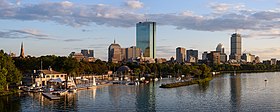    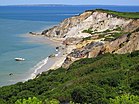  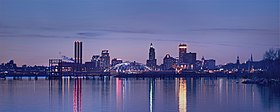 Left-right from top: Boston skyline, the Connecticut River valley, the Presidential Range, Burlington skyline, Aquinnah, Portland Head Light in Cape Elizabeth, skyline of Providence | |
 Flag | |
| Motto(s): None official. "An appeal to Heaven" and "Nunquam libertas gratior extat" (Latin: "Nowhere does liberty appear in a more gracious form") are common de facto mottos. | |
 Location within the United States | |
| Composition |
|
| Largest metropolitan area |
|
| Largest city | Boston |
| Area | |
| • Total | 71,991.8 sq mi (186,458 km2) |
| • Land | 62,688.4 sq mi (162,362 km2) |
| Population (2017 est.)[1] | |
| • Total | 14,810,001 |
| • Density | 210/sq mi (79/km2) |
| Demonym(s) | New Englander, Yankee[2] |
| GDP (nominal) [3] | |
| • Total | $1.1 trillion (2018-Q2) |
| • per capita | $73,000 (2018-Q2) |
| Dialects | New England English, New England French |

Brother Jonathan, the historical national personification of New England
New England is a region composed of six states of the northeastern United States: Maine, Vermont, New Hampshire, Massachusetts, Rhode Island, and Connecticut.[a] It is bordered by the state of New York to the west and by the Canadian provinces of New Brunswick and Quebec to the northeast and north, respectively. The Atlantic Ocean is to the east and southeast, and Long Island Sound is to the south. Boston is New England's largest city as well as the capital of Massachusetts. The largest metropolitan area is Greater Boston with nearly a third of the entire region's population, which also includes Worcester, Massachusetts (the second-largest city in New England), Manchester, New Hampshire (the largest city in New Hampshire), and Providence, Rhode Island (the capital and largest city of Rhode Island).
In 1620, Puritan Separatist Pilgrims from England established Plymouth Colony, the second successful English settlement in America, following the Jamestown Settlement in Virginia founded in 1607. Ten years later, more Puritans established Massachusetts Bay Colony north of Plymouth Colony. Over the next 126 years, people in the region fought in four French and Indian Wars, until the English colonists and their Iroquois allies defeated the French and their Algonquian allies in America. In 1692, the town of Salem, Massachusetts and surrounding areas experienced the Salem witch trials, one of the most infamous cases of mass hysteria in history.[10]
In the late 18th century, political leaders from the New England colonies initiated resistance to Britain's taxes without the consent of the colonists. Residents of Rhode Island captured and burned a British ship which was enforcing unpopular trade restrictions, and residents of Boston threw British tea into the harbor. Britain responded with a series of punitive laws stripping Massachusetts of self-government which were termed the "Intolerable Acts" by the colonists. These confrontations led to the first battles of the American Revolutionary War in 1775 and the expulsion of the British authorities from the region in spring 1776. The region played a prominent role in the movement to abolish slavery in the United States, and was the first region of the U.S. transformed by the Industrial Revolution, centered on the Blackstone and Merrimack river valleys.
The physical geography of New England is diverse for such a small area. Southeastern New England is covered by a narrow coastal plain, while the western and northern regions are dominated by the rolling hills and worn-down peaks of the northern end of the Appalachian Mountains. The Atlantic fall line lies close to the coast, which enabled numerous cities to take advantage of water power along the many rivers, such as the Connecticut River, which bisects the region from north to south.
Each state is subdivided into small incorporated municipalities known as towns, many of which are governed by town meetings. The only unincorporated areas exist in the sparsely populated northern regions of Maine, New Hampshire, and Vermont. New England is one of the Census Bureau's nine regional divisions and the only multi-state region with clear, consistent boundaries. It maintains a strong sense of cultural identity,[11] although the terms of this identity are often contrasted, combining Puritanism with liberalism, agrarian life with industry, and isolation with immigration.
.mw-parser-output .toclimit-2 .toclevel-1 ul,.mw-parser-output .toclimit-3 .toclevel-2 ul,.mw-parser-output .toclimit-4 .toclevel-3 ul,.mw-parser-output .toclimit-5 .toclevel-4 ul,.mw-parser-output .toclimit-6 .toclevel-5 ul,.mw-parser-output .toclimit-7 .toclevel-6 uldisplay:none
Contents
1 History
1.1 Colonial period
1.2 French and Indian Wars
1.3 Dominion of New England
1.4 New England in the new nation
1.5 Industrial Revolution
1.6 20th century and beyond
2 Geography
2.1 Geology
2.2 Climate
2.3 Regions
3 Demographics
3.1 Largest cities
4 Cities and urban areas
4.1 Metropolitan areas
4.2 State capitals
5 Economy
5.1 Urban centers
5.2 Agriculture
5.3 Energy
5.4 Employment
5.5 Overall tax burden
6 Government
6.1 Town meetings
6.2 Politics
6.3 Elections
6.3.1 Political party strength
6.3.2 New Hampshire primary
7 Education
7.1 Colleges and universities
7.2 Private and independent secondary schools
7.3 Public education
7.4 Academic journals and press
8 Culture
8.1 Cultural roots
8.2 Accents
8.3 Social activities and music
8.4 Media
8.4.1 Comedy
8.5 Literature
8.6 Film, television, and acting
9 Sports
9.1 Professional and semi-professional sports teams
10 Transportation
11 See also
12 Notes
13 References
13.1 Bibliography
14 Further reading
15 External links
History
The earliest known inhabitants of New England were American Indians who spoke a variety of the Eastern Algonquian languages.[12] Prominent tribes included the Abenakis, Mi'kmaq, Penobscot, Pequots, Mohegans, Narragansetts, Pocumtucks, and Wampanoag.[12] Prior to the arrival of European settlers, the Western Abenakis inhabited New Hampshire, New York, and Vermont, as well as parts of Quebec and western Maine.[13] Their principal town was Norridgewock in Maine.[14]
The Penobscot lived along the Penobscot River in Maine. The Narragansetts and smaller tribes under their sovereignty lived in Rhode Island, west of Narragansett Bay, including Block Island. The Wampanoag occupied southeastern Massachusetts, Rhode Island, and the islands of Martha's Vineyard and Nantucket. The Pocumtucks lived in Western Massachusetts, and the Mohegan and Pequot tribes lived in the Connecticut region. The Connecticut River Valley linked numerous tribes culturally, linguistically, and politically.[12]
As early as 1600, French, Dutch, and English traders began exploring the New World, trading metal, glass, and cloth for local beaver pelts.[12][15]
Colonial period

Title page of John Smith's A Description of New England (1616; 1865 reprint)
On April 10, 1606, King James I of England issued a charter for the Virginia Company, which comprised the London Company and the Plymouth Company. These two privately funded ventures were intended to claim land for England, to conduct trade, and to return a profit. In 1620, the Pilgrims arrived on the Mayflower and established Plymouth Colony in Massachusetts, beginning the history of permanent European settlement in New England.[16]
In 1616, English explorer John Smith named the region "New England".[17] The name was officially sanctioned on November 3, 1620[18] when the charter of the Virginia Company of Plymouth was replaced by a royal charter for the Plymouth Council for New England, a joint-stock company established to colonize and govern the region.[19] The Pilgrims wrote and signed the Mayflower Compact before leaving the ship,[20] and it became their first governing document.[21] The Massachusetts Bay Colony came to dominate the area and was established by royal charter in 1629[22][23] with its major town and port of Boston established in 1630.[24]
Massachusetts Puritans began to settle in Connecticut as early as 1633.[25]Roger Williams was banished from Massachusetts for heresy, led a group south, and founded Providence Plantation in the area that became the Colony of Rhode Island and Providence Plantations in 1636.[26][27] At this time, Vermont was yet unsettled, and the territories of New Hampshire and Maine were claimed and governed by Massachusetts.[28]
French and Indian Wars
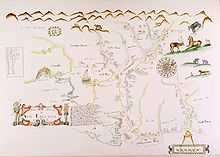
An English map of New England c. 1670 depicts the area around modern Portsmouth, New Hampshire
Relationships between colonists and local Indian tribes alternated between peace and armed skirmishes, the bloodiest of which was the Pequot War in 1637 which resulted in the Mystic massacre.[29] On May 19, 1643, the colonies of Massachusetts Bay, Plymouth, New Haven, and Connecticut joined together in a loose compact called the New England Confederation (officially "The United Colonies of New England"). The confederation was designed largely to coordinate mutual defense, and it gained some importance during King Philip's War[30] which pitted the colonists and their Indian allies against a widespread Indian uprising from June 1675 through April 1678, resulting in killings and massacres on both sides.[31]
During the next 74 years, there were six colonial wars that took place primarily between New England and New France,[32] during which New England was allied with the Iroquois Confederacy and New France was allied with the Wabanaki Confederacy. Mainland Nova Scotia came under the control of New England after the Siege of Port Royal (1710), but both New Brunswick and most of Maine remained contested territory between New England and New France. The British eventually defeated the French in 1763, opening the Connecticut River Valley for British settlement into western New Hampshire and Vermont.
The New England Colonies were settled primarily by farmers who became relatively self-sufficient. Later, New England's economy began to focus on crafts and trade, aided by the Puritan work ethic, in contrast to the Southern colonies which focused on agricultural production while importing finished goods from England.[33]
Dominion of New England

The New England Ensign, one of several flags historically associated with New England. This flag was reportedly used by colonial merchant ships sailing out of New England ports, 1686 – c. 1737.[34][35][36][37][38]

New England's Siege of Louisbourg (1745) by Peter Monamy
By 1686, King James II had become concerned about the increasingly independent ways of the colonies, including their self-governing charters, their open flouting of the Navigation Acts, and their growing military power. He therefore established the Dominion of New England, an administrative union comprising all of the New England colonies.[39] In 1688, the former Dutch colonies of New York, East New Jersey, and West New Jersey were added to the Dominion. The union was imposed from the outside and contrary to the rooted democratic tradition of the region, and it was highly unpopular among the colonists.[40]
The Dominion significantly modified the charters of the colonies, including the appointment of Royal Governors to nearly all of them. There was an uneasy tension between the Royal Governors, their officers, and the elected governing bodies of the colonies. The governors wanted unlimited authority, and the different layers of locally elected officials would often resist them. In most cases, the local town governments continued operating as self-governing bodies, just as they had before the appointment of the governors.[41]
After the Glorious Revolution in 1689, Bostonians overthrew royal governor Sir Edmund Andros. They seized dominion officials and adherents to the Church of England during a popular and bloodless uprising.[42] These tensions eventually culminated in the American Revolution, boiling over with the outbreak of the War of American Independence in 1775. The first battles of the war were fought in Lexington and Concord, Massachusetts, later leading to the Siege of Boston by continental troops. In March 1776, British forces were compelled to retreat from Boston.
New England in the new nation
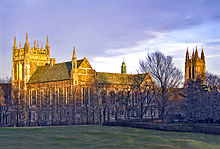
Boston College: the architecture style is Collegiate Gothic, a subgenre of Gothic Revival architecture, a 19th-century movement
After the dissolution of the Dominion of New England, the colonies of New England ceased to function as a unified political unit but remained a defined cultural region. By 1784, all of the states in the region had taken steps towards the abolition of slavery, with Vermont and Massachusetts introducing total abolition in 1777 and 1783, respectively.[43] The nickname "Yankeeland" was sometimes used to denote the New England area, especially among Southerners and the British.[44]
Vermont was admitted to statehood in 1791 after settling a dispute with New York. The territory of Maine had been a part of Massachusetts, but it was granted statehood on March 15, 1820 as part of the Missouri Compromise.[45] Today, New England is defined as the six states of Maine, Vermont, New Hampshire, Massachusetts, Rhode Island, and Connecticut.[5]
New England's economic growth relied heavily on trade with the British Empire,[46] and the region's merchants and politicians strongly opposed trade restrictions. As the United States and the United Kingdom fought the War of 1812, New England Federalists organized the Hartford Convention in the winter of 1814 to discuss the region's grievances concerning the war, and to propose changes to the Constitution to protect the region's interests and maintain its political power.[47] Radical delegates within the convention proposed the region's secession from the United States, but they were outnumbered by moderates who opposed the idea.[48]
Politically, the region often disagreed with the rest of the country.[49] Massachusetts and Connecticut were among the last refuges of the Federalist Party, and New England became the strongest bastion of the new Whig Party when the Second Party System began in the 1830s. The Whigs were usually dominant throughout New England, except in the more Democratic Maine and New Hampshire. Leading statesmen hailed from the region, including Daniel Webster.
Many notable literary and intellectual figures were New Englanders, including Ralph Waldo Emerson, Henry David Thoreau, Nathaniel Hawthorne, Henry Wadsworth Longfellow, John Greenleaf Whittier, George Bancroft, and William H. Prescott.[50]
Industrial Revolution

The Slater Mill Historic Site in Pawtucket, Rhode Island
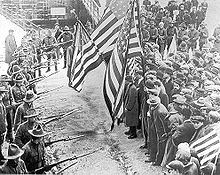
Bread and Roses Strike. Massachusetts National Guard troops surround strikers in Lawrence, Massachusetts, 1912.
New England was key to the industrial revolution in the United States.[51] The Blackstone Valley running through Massachusetts and Rhode Island has been called the birthplace of America's industrial revolution.[52] In 1787, the first cotton mill in America was founded in the North Shore seaport of Beverly, Massachusetts as the Beverly Cotton Manufactory.[53] The Manufactory was also considered the largest cotton mill of its time. Technological developments and achievements from the Manufactory led to the development of more advanced cotton mills, including Slater Mill in Pawtucket, Rhode Island. Towns such as Lawrence, Massachusetts, Lowell, Massachusetts, Woonsocket, Rhode Island, and Lewiston, Maine became centers of the textile industry following the innovations at Slater Mill and the Beverly Cotton Manufactory.[citation needed]
The Connecticut River Valley became a crucible for industrial innovation, particularly the Springfield Armory, pioneering such advances as interchangeable parts and the assembly line which influenced manufacturing processes all around the world.[54] From early in the nineteenth century until the mid-twentieth, the region surrounding Springfield, Massachusetts and Hartford, Connecticut served as the United States' epicenter for advanced manufacturing, drawing skilled workers from all over the world.[55][56]
The rapid growth of textile manufacturing in New England between 1815 and 1860 caused a shortage of workers. Recruiters were hired by mill agents to bring young women and children from the countryside to work in the factories. Between 1830 and 1860, thousands of farm girls moved from rural areas where there was no paid employment to work in the nearby mills, such as the famous Lowell Mill Girls. As the textile industry grew, immigration also grew. By the 1850s, immigrants began working in the mills, especially Irish and French Canadians.[57]
New England as a whole was the most industrialized part of the U.S. By 1850, the region accounted for well over a quarter of all manufacturing value in the country and over a third of its industrial workforce.[58] It was also the most literate and most educated region in the country.[58]
During the same period, New England and areas settled by New Englanders (upstate New York, Ohio's Western Reserve, and the upper midwestern states of Michigan and Wisconsin) were the center of the strongest abolitionist and anti-slavery movements in the United States, coinciding with the Protestant Great Awakening in the region.[59] Abolitionists who demanded immediate emancipation such as William Lloyd Garrison, John Greenleaf Whittier and Wendell Phillips had their base in the region. So too did anti-slavery politicians who wanted to limit the growth of slavery, such as John Quincy Adams, Charles Sumner, and John P. Hale. When the anti-slavery Republican Party was formed in the 1850s, all of New England, including areas that had previously been strongholds for both the Whig and the Democratic Parties, became strongly Republican. New England remained solidly Republican until Catholics began to mobilize behind the Democrats, especially in 1928, and up until the Republican party realigned its politics in a shift known as the Southern strategy. This led to the end of "Yankee Republicanism" and began New England's relatively swift transition into a consistently Democratic stronghold.[60]
20th century and beyond

Autumn in New England, watercolor, Maurice Prendergast. C. 1910–1913
The flow of immigrants continued at a steady pace from the 1840s until cut off by World War I. The largest numbers came from Ireland and Britain before 1890, and after that from Quebec, Italy and Southern Europe. The immigrants filled the ranks of factory workers, craftsmen and unskilled laborers. The Irish assumed a larger and larger role in the Democratic Party in the cities and statewide, while the rural areas remained Republican. Yankees left the farms, which never were highly productive; many headed west, while others became professionals and businessmen in the New England cities.
The Great Depression in the United States of the 1930s hit the region hard, with high unemployment in the industrial cities. The Democrats appealed to factory workers and especially Catholics, pulling them into the New Deal coalition and making the once-Republican region into one that was closely divided. However the enormous spending on munitions, ships, electronics, and uniforms during World War II caused a burst of prosperity in every sector.

Fall foliage in the town of Stowe, Vermont
The region lost most of its factories starting with the loss of textiles in the 1930s and getting worse after 1960. The New England economy was radically transformed after World War II. The factory economy practically disappeared. Like urban centers in the Rust Belt, once-bustling New England communities fell into economic decay following the flight of the region's industrial base. The textile mills one by one went out of business from the 1920s to the 1970s. For example, the Crompton Company, after 178 years in business, went bankrupt in 1984, costing the jobs of 2,450 workers in five states. The major reasons were cheap imports, the strong dollar, declining exports, and a failure to diversify.[61] The shoe industry subsequently left the region as well.

Alexander King House in Suffield, Connecticut
What remains is very high technology manufacturing, such as jet engines, nuclear submarines, pharmaceuticals, robotics, scientific instruments, and medical devices. MIT (the Massachusetts Institute of Technology) invented the format for university-industry relations in high tech fields, and spawned many software and hardware firms, some of which grew rapidly.[62] By the 21st century the region had become famous for its leadership roles in the fields of education, medicine and medical research, high-technology, finance, and tourism.[63]
Some industrial areas were slow in adjusting to the new service economy. In 2000, New England had two of the ten poorest cities (by percentage living below the poverty line) in the U.S.: the state capitals of Providence, Rhode Island and Hartford, Connecticut.[64] They were no longer in the bottom ten by 2010; Connecticut, Massachusetts, and New Hampshire remain among the ten wealthiest states in the United States in terms of median household income and per capita income.[65]
Geography
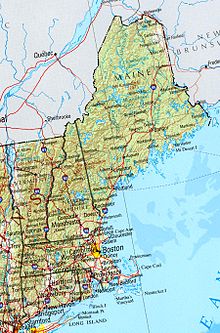
A political and geographical map of New England shows the coastal plains in the southeast, and hills, mountains and valleys in the west and the north.
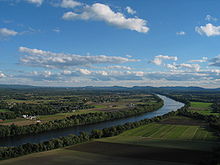
A portion of the north-central Pioneer Valley in Sunderland, Massachusetts
The states of New England have a combined area of 71,991.8 square miles (186,458 km2), making the region slightly larger than the state of Washington and larger than England.[66][67] Maine alone constitutes nearly one-half of the total area of New England, yet is only the 39th-largest state, slightly smaller than Indiana. The remaining states are among the smallest in the U.S., including the smallest state—Rhode Island.
Geology
New England's long rolling hills, mountains, and jagged coastline are glacial landforms resulting from the retreat of ice sheets approximately 18,000 years ago, during the last glacial period.[68][69]
New England is geologically a part of the New England province, an exotic terrane region consisting of the Appalachian Mountains, the New England highlands, and the seaboard lowlands.[70] The Appalachian Mountains roughly follow the border between New England and New York. The Berkshires in Massachusetts and Connecticut, and the Green Mountains in Vermont, as well as the Taconic Mountains, form a spine of Precambrian rock.[71]
The Appalachians extend northwards into New Hampshire as the White Mountains, and then into Maine and Canada. Mount Washington in New Hampshire is the highest peak in the Northeast, although it is not among the ten highest peaks in the eastern United States.[72] It is the site of the second highest recorded wind speed on Earth,[73][74] and has the reputation of having the world's most severe weather.[75][76]
The coast of the region, extending from southwestern Connecticut to northeastern Maine, is dotted with lakes, hills, marshes and wetlands, and sandy beaches.[69] Important valleys in the region include the Connecticut River Valley and the Merrimack Valley.[69] The longest river is the Connecticut River, which flows from northeastern New Hampshire for 407 mi (655 km), emptying into Long Island Sound, roughly bisecting the region. Lake Champlain, which forms part of the border between Vermont and New York, is the largest lake in the region, followed by Moosehead Lake in Maine and Lake Winnipesaukee in New Hampshire.[69]
Climate

Köppen climate types in New England

The White Mountains of New Hampshire are part of the Appalachian Mountains.
The climate of New England varies greatly across its 500 miles (800 km) span from northern Maine to southern Connecticut:
Maine, New Hampshire, Vermont, and western Massachusetts have a humid continental climate (Dfb in Köppen climate classification). In this region the winters are long, cold, and heavy snow is common (most locations receive 60 to 120 inches (1,500 to 3,000 mm) of snow annually in this region). The summer's months are moderately warm, though summer is rather short and rainfall is spread through the year.
In central and eastern Massachusetts, Rhode Island, and northern Connecticut, the same humid continental prevails (Dfa), though summers are warm to hot, winters are shorter, and there is less snowfall (especially in the coastal areas where it is often warmer).
Southern and coastal Connecticut is the broad transition zone from the cold continental climates of the north to the milder subtropical climates to the south. The frost free season is greater than 180 days across far southern/coastal Connecticut, coastal Rhode Island, and the islands (Nantucket and Martha's Vineyard). Winters also tend to be much sunnier in southern Connecticut and southern Rhode Island compared to the rest of New England.[77]
Regions
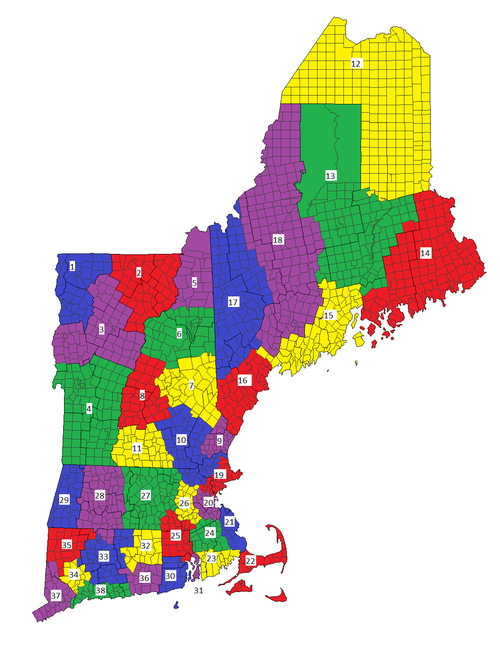
2. Northeast Kingdom
3. Central Vermont
4. Southern Vermont
5. Great North Woods Region
6. White Mountains
7. Lakes Region
8. Dartmouth/Lake Sunapee Region
9. Seacoast Region
10. Merrimack Valley
11. Monadnock Region
12. Aroostook
13. Maine Highlands
14. Acadia/Down East
15. Mid-Coast/Penobscot Bay
16. Southern Maine/South Coast
17. Mountain and Lakes Region
18. Kennebec Valley
19. North Shore
20. Metro Boston
21. South Shore
22. Cape Cod and Islands
23. South Coast
24. Southeastern Massachusetts
25. Blackstone River Valley
26. Metrowest/Greater Boston
27. Central Massachusetts
28. Pioneer Valley
29. The Berkshires
30. South County
31. East Bay
32. Quiet Corner
33. Greater Hartford
34. Central Naugatuck Valley
35. Northwest Hills
36. Southeastern Connecticut/Greater New London
37. Western Connecticut
38. Connecticut Shoreline
Demographics

Largest self-reported ancestry groups in New England. Americans of Irish descent form a plurality in most of Massachusetts, while Americans of English descent form a plurality in much of the central parts of Vermont and New Hampshire as well as nearly all of Maine.
In 2010, New England had a population of 14,444,865, a growth of 3.8% from 2000.[78] This grew to an estimated 14,727,584 by 2015.[79] Massachusetts is the most populous state with 6,794,422 residents, while Vermont is the least populous state with 626,042 residents.[78] Boston is by far the region's most populous city and metropolitan area.
Although a great disparity exists between New England's northern and southern portions, the region's average population density is 234.93 inhabitants/sq mi (90.7/km2). New England has a significantly higher population density than that of the U.S. as a whole (79.56/sq mi), or even just the contiguous 48 states (94.48/sq mi). Three-quarters of the population of New England, and most of the major cities, are in the states of Connecticut, Massachusetts, and Rhode Island. The combined population density of these states is 786.83/sq mi, compared to northern New England's 63.56/sq mi (2000 census).
According to the 2006–08 American Community Survey, 48.7% of New Englanders were male and 51.3% were female. Approximately 22.4% of the population were under 18 years of age; 13.5% were over 65 years of age. The six states of New England have the lowest birth rate in the U.S.[80]
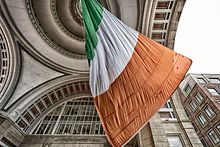
World's largest Irish flag in Boston. People who claim Irish descent constitute the largest ethnic group in New England.
White Americans make up the majority of New England's population at 83.4% of the total population, Hispanic and Latino Americans are New England's largest minority, and they are the second-largest group in the region behind non-Hispanic European Americans. As of 2014, Hispanics and Latinos of any race made up 10.2% of New England's population. Connecticut had the highest proportion at 13.9%, while Vermont had the lowest at 1.3%. There were nearly 1.5 million Hispanic and Latino individuals reported in New England in 2014. Puerto Ricans were the most numerous of the Hispanic and Latino subgroups. Over 660,000 Puerto Ricans lived in New England in 2014, forming 4.5% of the population. The Dominican population is over 200,000, and the Mexican and Guatemalan populations are each over 100,000.[81]Americans of Cuban descent are scant in number; there were roughly 26,000 Cuban Americans in the region in 2014. People of all other Hispanic and Latino ancestries, including Salvadoran, Colombian, and Bolivian, formed 2.5% of New England's population, and numbered over 361,000 combined.[81]
According to the 2014 American Community Survey, the top ten largest reported European ancestries were the following:[82]
Irish: 19.2% (2.8 million)
Italian: 13.6% (2.0 million)
French and French Canadian: 13.1% (1.9 million)
English: 11.9% (1.7 million)[83]
German: 7.4% (1.1 million)
Polish: 4.9% (roughly 715,000)
Portuguese: 3.2% (467,000)
Scottish: 2.5% (370,000)
Russian: 1.4% (206,000)
Greek: 1.0% (152,000)
English is, by far, the most common language spoken at home. Approximately 81.3% of all residents (11.3 million people) over the age of five spoke only English at home. Roughly 1,085,000 people (7.8% of the population) spoke Spanish at home, and roughly 970,000 people (7.0% of the population) spoke other Indo-European languages at home.[84] Over 403,000 people (2.9% of the population) spoke an Asian or Pacific Island language at home.[85] Slightly fewer (about 1%) spoke French at home,[86] although this figure is above 20% in northern New England, which borders francophone Québec.[citation needed] Roughly 99,000 people (0.7% of the population) spoke languages other than these at home.[85]
As of 2014, approximately 87% of New England's inhabitants were born in the U.S., while over 12% were foreign-born.[87] 35.8% of foreign-born residents were born in Latin America, 28.6% were born in Asia, 22.9% were born in Europe, and 8.5% were born in Africa.[88]
Southern New England forms an integral part of the BosWash megalopolis, a conglomeration of urban centers that spans from Boston to Washington, D.C. The region includes three of the four most densely populated states in the U.S.; only New Jersey has a higher population density than the states of Rhode Island, Massachusetts, and Connecticut.
Greater Boston, which includes parts of southern New Hampshire, has a total population of approximately 4.8 million,[89] while over half the population of New England falls inside Boston's Combined Statistical Area of over 8.2 million.[90]
Largest cities
The most populous cities as of the Census Bureau's 2014 estimates were (metropolitan areas in parentheses):[89][91]
 Boston, Massachusetts: 655,884 (4,739,385)
Boston, Massachusetts: 655,884 (4,739,385) Worcester, Massachusetts: 183,016 (931,802)
Worcester, Massachusetts: 183,016 (931,802) Providence, Rhode Island: 179,154 (1,609,533)
Providence, Rhode Island: 179,154 (1,609,533) Springfield, Massachusetts: 153,991 (630,672)
Springfield, Massachusetts: 153,991 (630,672) Bridgeport, Connecticut: 147,612 (945,816)
Bridgeport, Connecticut: 147,612 (945,816) New Haven, Connecticut: 130,282 (861,238)
New Haven, Connecticut: 130,282 (861,238) Stamford, Connecticut: 128,278 (part of Bridgeport's MSA)
Stamford, Connecticut: 128,278 (part of Bridgeport's MSA) Hartford, Connecticut: 124,705 (1,213,225)
Hartford, Connecticut: 124,705 (1,213,225) Manchester, New Hampshire: 110,448 (405,339)
Manchester, New Hampshire: 110,448 (405,339) Lowell, Massachusetts: 109,945 (part of Greater Boston)
Lowell, Massachusetts: 109,945 (part of Greater Boston)
During the 20th century, urban expansion in regions surrounding New York City has become an important economic influence on neighboring Connecticut, parts of which belong to the New York metropolitan area. The U.S. Census Bureau groups Fairfield, New Haven and Litchfield counties in western Connecticut together with New York City, and other parts of New York and New Jersey as a combined statistical area.[92]
- Major cities of New England

1. Boston, Massachusetts
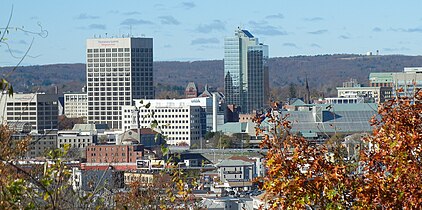
2. Worcester, Massachusetts
3. Providence, Rhode Island

4. Springfield, Massachusetts

5. Bridgeport, Connecticut

6. New Haven, Connecticut

7. Stamford, Connecticut

8. Hartford, Connecticut
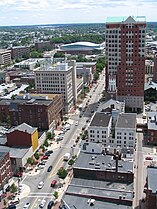
9. Manchester, New Hampshire
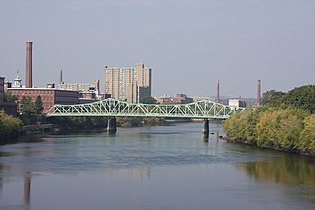
10. Lowell, Massachusetts
Cities and urban areas
Metropolitan areas
The following are metropolitan statistical areas as defined by the United States Census Bureau.
- Bangor, ME MSA
Barnstable Town, MA MSA (Greater Boston)
Boston-Cambridge-Newton, MA-NH MSA (Greater Boston)
Bridgeport-Stamford-Norwalk, CT MSA (New York-Newark CSA)- Burlington-South Burlington, VT MSA
- Hartford-West Hartford-East Hartford, CT MSA
- Lewiston-Auburn, ME MSA
- Manchester-Nashua, NH MSA
New Haven-Milford, CT MSA (New York-Newark CSA)- Norwich-New London, CT MSA
- Pittsfield, MA MSA
- Portland-South Portland, ME MSA
- Springfield, MA MSA
Providence-Warwick, RI-MA MSA (Greater Boston)
Worcester, MA-CT MSA (Greater Boston)
State capitals
- Hartford, Connecticut
- Augusta, Maine
- Boston, Massachusetts
- Concord, New Hampshire
- Providence, Rhode Island
- Montpelier, Vermont
Economy

Old Port (Wharf Street) in Portland, Maine
Several factors combine to make the New England economy unique. The region is distant from the geographic center of the country, and it is a relatively small region but densely populated. It historically has been an important center of industry and manufacturing and a supplier of natural resource products, such as granite, lobster, and codfish. The service industry is important, including tourism, education, financial and insurance services, and architectural, building, and construction services. The U.S. Department of Commerce has called the New England economy a microcosm for the entire U.S. economy.[93]
The region underwent a long period of deindustrialization in the first half of the 20th century, as traditional manufacturing companies relocated to the Midwest, with textile and furniture manufacturing migrating to the South. In the late-20th century, an increasing portion of the regional economy included high technology, military defense industry, finance and insurance services, and education and health services. As of 2015, the GDP of New England was $953.9 billion.[94]

Vermont maple syrup
New England exports food products ranging from fish to lobster, cranberries, potatoes, and maple syrup. About half of the region's exports consist of industrial and commercial machinery, such as computers and electronic and electrical equipment. Granite is quarried at Barre, Vermont,[95] guns made at Springfield, Massachusetts and Saco, Maine, submarines at Groton, Connecticut and Bath, Maine, and hand tools at Turners Falls, Massachusetts.
Urban centers
In 2017, Boston was ranked as having the ninth-most competitive financial center in the world and the fourth-most competitive in the United States.[96] Boston-based Fidelity Investments helped popularize the mutual fund in the 1980s and has made Boston one of the top financial centers in the United States.[97][98] The city is home to the headquarters of Santander Bank and a center for venture capital firms. State Street Corporation specializes in asset management and custody services and is based in the city.
Boston is also a printing and publishing center.[99]Houghton Mifflin Harcourt is headquartered there, along with Bedford-St. Martin's and Beacon Press. The city is also home to the Hynes Convention Center in the Back Bay, and the Seaport Hotel and Seaport World Trade Center and Boston Convention and Exhibition Center on the South Boston waterfront.[100]
The General Electric Corporation announced its decision to move the company's global headquarters to the Boston Seaport District from Fairfield, Connecticut in 2016, citing factors including Boston's preeminence in the realm of higher education.[101] The city also holds the headquarters to several major athletic and footwear companies, including Converse, New Balance, and Reebok. Rockport, Puma, and Wolverine World Wide have headquarters or regional offices[102] just outside the city.[103]
Hartford is the historic international center of the insurance industry, with companies such as Aetna, Conning & Company, The Hartford, Harvard Pilgrim Health Care, The Phoenix Companies, and Hartford Steam Boiler based in the city, and The Travelers Companies and Lincoln National Corporation have major operations in the city. It is also home to the corporate headquarters of U.S. Fire Arms Mfg. Co., United Technologies, and Virtus Investment Partners.[104]
Fairfield County, Connecticut has a large concentration of investment management firms in the area, most notably Bridgewater Associates (one of the world's largest hedge fund companies), Aladdin Capital Management, and Point72 Asset Management. Moreover, many international banks have their North American headquarters in Fairfield County, such as Royal Bank of Scotland Group and UBS.
Agriculture
Agriculture is limited by the area's rocky soil, cool climate, and small area. Some New England states, however, are ranked highly among U.S. states for particular areas of production. Maine is ranked ninth for aquaculture,[105] and has abundant potato fields in its northeast part. Vermont is fifteenth for dairy products,[106] and Connecticut and Massachusetts seventh and eleventh for tobacco, respectively.[107][108] Cranberries are grown in Massachusetts' Cape Cod-Plymouth-South Shore area, and blueberries in Maine.
Energy

Seabrook Station Nuclear Power Plant in Seabrook, New Hampshire
The region is mostly energy-efficient compared to the U.S. at large, with every state but Maine ranking within the ten most energy-efficient states;[109] every state in New England also ranks within the ten most expensive states for electricity prices.[110]
Employment
| Employment area | October 2010 | October 2011 | October 2012 | October 2013 | December 2014 | December 2015[111] | December 2016[112] | Net change |
|---|---|---|---|---|---|---|---|---|
| United States | 9.7 | 9.0 | 7.9 | 7.2 | 5.6 | 5.0 | 4.7 | −5.0 |
| New England | 8.3 | 7.6 | 7.4 | 7.1 | 5.4 | 4.3 | 3.5 | −4.7 |
| Connecticut | 9.1 | 8.7 | 9.0 | 7.6 | 6.4 | 5.2 | 4.4 | −4.7 |
| Maine | 7.6 | 7.3 | 7.4 | 6.5 | 5.5 | 4.0 | 3.8 | −3.8 |
| Massachusetts | 8.3 | 7.3 | 6.6 | 7.2 | 5.5 | 4.7 | 2.8 | −5.5 |
| New Hampshire | 5.7 | 5.3 | 5.7 | 5.2 | 4.0 | 3.1 | 2.6 | −3.1 |
| Rhode Island | 11.5 | 10.4 | 10.4 | 9.4 | 6.8 | 5.1 | 5.0 | −6.5 |
| Vermont | 5.9 | 5.6 | 5.5 | 4.4 | 4.2 | 3.6 | 3.1 | −2.8 |
As of January 2017, employment is stronger in New England than in the rest of the United States. During the Great Recession, unemployment rates ballooned across New England as elsewhere; however, in the years that followed, these rates declined steadily, with New Hampshire and Massachusetts having the lowest unemployment rates in the country, respectively. The most extreme swing was in Rhode Island, which had an unemployment rate above 10% following the recession, but which saw this rate decline by over 6% in six years.
As of December 2016, the metropolitan statistical area (MSA) with the lowest unemployment rate, 2.1%, was Burlington-South Burlington, Vermont; the MSA with the highest rate, 4.9%, was Waterbury, Connecticut.[113]
Overall tax burden
In 2018, four of the six New England states were among the top ten states in the country in terms of taxes paid per taxpayer. The rankings included #3 Maine (11.02%), #4 Vermont (10.94%), #6 Connecticut (10.19%), and #7 Rhode Island (10.14%). Additionally New Hampshire, Vermont, Maine and Rhode Island took four of the top five spots for "Highest Property Tax as a Percentage of Personal Income".[114]
Government
Town meetings
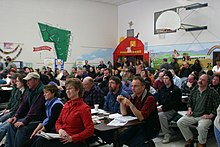
A New England town meeting in Huntington, Vermont
New England town meetings were derived from meetings held by church elders, and are still an integral part of government in many New England towns. At such meetings, any citizen of the town may discuss issues with other members of the community and vote on them. This is the strongest example of direct democracy in the U.S. today, and the strong democratic tradition was even apparent in the early 19th century, when Alexis de Tocqueville wrote in Democracy in America:
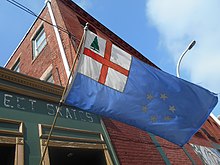
Flag of the New England Governor's Conference, which uses a blue field instead of the traditional red.
| “ | New England, where education and liberty are the daughters of morality and religion, where society has acquired age and stability enough to enable it to form principles and hold fixed habits, the common people are accustomed to respect intellectual and moral superiority and to submit to it without complaint, although they set at naught all those privileges which wealth and birth have introduced among mankind. In New England, consequently, the democracy makes a more judicious choice than it does elsewhere.[115] | ” |
By contrast, James Madison wrote in Federalist No. 55 that, regardless of the assembly, "passion never fails to wrest the scepter from reason. Had every Athenian citizen been a Socrates, every Athenian assembly would still have been a mob."[116] The use and effectiveness of town meetings is still discussed by scholars, as well as the possible application of the format to other regions and countries.[117]
Politics
Elections
State and national elected officials in New England recently have been elected mainly from the Democratic Party.[118] The region is generally considered to be the most liberal in the United States, with more New Englanders identifying as liberals than Americans elsewhere. In 2010, four of six of the New England states were polled as the most liberal in the United States.[119]
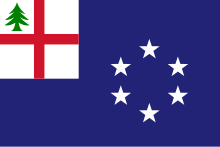
Flag of the New England Governor's Conference (NEGC)
The six states of New England voted for the Democratic presidential nominee in the 1992, 1996, 2004, 2008, 2012, and 2016 elections, and every New England state other than New Hampshire voted for Al Gore in the presidential election of 2000. In the 113th Congress, the House delegations from all six states of New England were all Democratic. New England is home to the only two independents currently serving in the Senate, both of whom caucus with the Democratic Party: Bernie Sanders, a self-described democratic socialist,[120][121] representing Vermont, and Angus King, an Independent representing Maine.
In the 2008 presidential election, Barack Obama carried all six New England states by 9 percentage points or more.[122] He carried every county in New England except for Piscataquis County, Maine, which he lost by 4% to Senator John McCain (R-AZ). Pursuant to the reapportionment following the 2010 census, New England collectively has 33 electoral votes.
The following table presents the vote percentage for the popular-vote winner for each New England state, New England as a whole, and the United States as a whole, in each presidential election from 1900 to 2016, with the vote percentage for the Republican candidate shaded in red and the vote percentage for the Democratic candidate shaded in blue:
| Year | Connecticut | Maine | Massachusetts | New Hampshire | Rhode Island | Vermont | New England | United States |
|---|---|---|---|---|---|---|---|---|
| 2016 | 54.6% | 47.8% | 60.0% | 46.8% | 54.4% | 56.7% | 55.3% | 48.2% |
| 2012 | 58.1% | 56.3% | 60.7% | 52.0% | 62.7% | 66.6% | 59.1% | 51.1% |
| 2008 | 60.6% | 57.7% | 61.8% | 54.1% | 62.9% | 67.5% | 60.6% | 52.9% |
| 2004 | 54.3% | 53.6% | 61.9% | 50.2% | 59.4% | 58.9% | 57.7% | 50.7% |
| 2000 | 55.9% | 49.1% | 59.8% | 48.1% | 61.0% | 50.6% | 56.1% | 48.4% |
| 1996 | 52.8% | 51.6% | 61.5% | 49.3% | 59.7% | 53.4% | 56.8% | 49.2% |
| 1992 | 42.2% | 38.8% | 47.5% | 38.9% | 47.0% | 46.1% | 44.4% | 43.0% |
| 1988 | 52.0% | 55.3% | 53.2% | 62.5% | 55.6% | 51.1% | 49.5% | 53.4% |
| 1984 | 60.7% | 60.8% | 51.2% | 68.7% | 51.7% | 57.9% | 56.2% | 58.8% |
| 1980 | 48.2% | 45.6% | 41.9% | 57.7% | 47.7% | 44.4% | 44.7% | 50.8% |
| 1976 | 52.1% | 48.9% | 56.1% | 54.7% | 55.4% | 54.3% | 51.7% | 50.1% |
| 1972 | 58.6% | 61.5% | 54.2% | 64.0% | 53.0% | 62.7% | 52.5% | 60.7% |
| 1968 | 49.5% | 55.3% | 63.0% | 52.1% | 64.0% | 52.8% | 56.1% | 43.4% |
| 1964 | 67.8% | 68.8% | 76.2% | 63.9% | 80.9% | 66.3% | 72.8% | 61.1% |
| 1960 | 53.7% | 57.0% | 60.2% | 53.4% | 63.6% | 58.6% | 56.0% | 49.7% |
| 1956 | 63.7% | 70.9% | 59.3% | 66.1% | 58.3% | 72.2% | 62.0% | 57.4% |
| 1952 | 55.7% | 66.0% | 54.2% | 60.9% | 50.9% | 71.5% | 56.1% | 55.2% |
| 1948 | 49.5% | 56.7% | 54.7% | 52.4% | 57.6% | 61.5% | 51.5% | 49.6% |
| 1944 | 52.3% | 52.4% | 52.8% | 52.1% | 58.6% | 57.1% | 52.4% | 53.4% |
| 1940 | 53.4% | 51.1% | 53.1% | 53.2% | 56.7% | 54.8% | 52.8% | 54.7% |
| 1936 | 55.3% | 55.5% | 51.2% | 49.7% | 53.1% | 56.4% | 50.9% | 60.8% |
| 1932 | 48.5% | 55.8% | 50.6% | 50.4% | 55.1% | 57.7% | 49.1% | 57.4% |
| 1928 | 53.6% | 68.6% | 50.2% | 58.7% | 50.2% | 66.9% | 53.2% | 58.2% |
| 1924 | 61.5% | 72.0% | 62.3% | 59.8% | 59.6% | 78.2% | 63.3% | 54.0% |
| 1920 | 62.7% | 68.9% | 68.5% | 59.8% | 64.0% | 75.8% | 66.7% | 60.3% |
| 1916 | 49.8% | 51.0% | 50.5% | 49.1% | 51.1% | 62.4% | 51.1% | 49.2% |
| 1912 | 39.2% | 39.4% | 35.5% | 39.5% | 39.0% | 37.1% | 36.6% | 41.8% |
| 1908 | 59.4% | 63.0% | 58.2% | 59.3% | 60.8% | 75.1% | 60.2% | 51.6% |
| 1904 | 58.1% | 67.4% | 57.9% | 60.1% | 60.6% | 78.0% | 60.4% | 56.4% |
| 1900 | 56.9% | 61.9% | 57.6% | 59.3% | 59.7% | 75.7% | 59.4% | 51.6% |
Political party strength
Judging purely by party registration rather than voting patterns, New England today is one of the most Democratic regions in the U.S.[123][124][125] According to Gallup, Connecticut, Massachusetts, Rhode Island, and Vermont are "solidly Democratic", Maine "leans Democratic", and New Hampshire is a swing state.[126] Though New England is today considered a Democratic Party stronghold, much of the region was staunchly Republican before the mid-twentieth century. This changed in the late 20th century, in large part due to demographic shifts[127] and the Republican Party's adoption of socially conservative platforms as part of their strategic shift towards the South.[60] For example, Vermont voted Republican in every presidential election but one from 1856 through 1988, and has voted Democratic every election since. Maine and Vermont were the only two states in the nation to vote against Democrat Franklin D. Roosevelt all four times he ran for president. Republicans in New England are today considered by both liberals and conservatives to be more moderate (socially liberal) compared to Republicans in other parts of the U.S.[128]
† Elected as an independent, but caucuses with the Democratic Party.
| State | Governor | Senior U.S. Senator | Junior U.S. Senator | U.S. House Delegation | Upper House Majority | Lower House Majority |
|---|---|---|---|---|---|---|
| CT | N. Lamont | R. Blumenthal | C. Murphy | Democratic 5–0 | Democratic 21–13 | Democratic 92–59 |
| ME | J. Mills | S. Collins | A. King[†] | Democratic 2-0 | Democratic 21–14 | Democratic 88–56–6 |
| MA | C. Baker | E. Warren | E. Markey | Democratic 9–0 | Democratic 34–6 | Democratic 127–32 |
| NH | C. Sununu | J. Shaheen | M. Hassan | Democratic 2-0 | Democratic 14–10 | Democratic 233-167 |
| RI | G. Raimondo | J. Reed | S. Whitehouse | Democratic 2–0 | Democratic 33–5 | Democratic 66-9 |
| VT | P. Scott | P. Leahy | B. Sanders[†] | Democratic 1–0 | Democratic 21–7–2 | Democratic 83–53–7–7 |

Alumni Hall at Saint Anselm College has served as a backdrop for the media reports during the New Hampshire primary.
New Hampshire primary
Historically, the New Hampshire primary has been the first in a series of nationwide political party primary elections held in the United States every four years. Held in the state of New Hampshire, it usually marks the beginning of the U.S. presidential election process. Even though few delegates are chosen from New Hampshire, the primary has always been pivotal to both New England and American politics. One college in particular, Saint Anselm College, has been home to numerous national presidential debates and visits by candidates to its campus.[129]
Education
Colleges and universities

New England is home to four of the eight Ivy League universities. Pictured here is Dartmouth Hall on the campus of Dartmouth College.
New England contains some of the oldest and most renowned institutions of higher learning in the United States and the world. Harvard College was the first such institution, founded in 1636 at Cambridge, Massachusetts to train preachers. Yale University was founded in Saybrook, Connecticut in 1701, and awarded the nation's first doctoral (PhD) degree in 1861. Yale moved to New Haven, Connecticut in 1718, where it has remained to the present day.
Brown University was the first college in the nation to accept students of all religious affiliations, and is the seventh oldest U.S. institution of higher learning. It was founded in Providence, Rhode Island in 1764. Dartmouth College was founded five years later in Hanover, New Hampshire with the mission of educating the local American Indian population as well as English youth. The University of Vermont, the fifth oldest university in New England, was founded in 1791, the same year that Vermont joined the Union.
In addition to four out of eight Ivy League schools, New England contains the Massachusetts Institute of Technology (MIT), Tufts University, four of the original Seven Sisters, the bulk of educational institutions that are identified as the "Little Ivies", one of the eight original Public Ivies, the Colleges of Worcester Consortium in central Massachusetts, and the Five Colleges consortium in western Massachusetts. The University of Maine, the University of New Hampshire, the University of Connecticut, the University of Massachusetts at Amherst, the University of Rhode Island, and the University of Vermont are the flagship state universities in the region.
Private and independent secondary schools
At the pre-college level, New England is home to a number of American independent schools (also known as private schools). The concept of the elite "New England prep school" (preparatory school) and the "preppy" lifestyle is an iconic part of the region's image.[130]
- See the list of private schools for each state:
Connecticut, Massachusetts, Maine, New Hampshire, Rhode Island, Vermont.
Public education

Boston Latin School is the oldest public school in the U.S., established in 1635.
New England is home to some of the oldest public schools in the nation. Boston Latin School is the oldest public school in America and was attended by several signatories of the Declaration of Independence.[131]Hartford Public High School is the second oldest operating high school in the U.S.[132]
As of 2005, the National Education Association ranked Connecticut as having the highest-paid teachers in the country. Massachusetts and Rhode Island ranked eighth and ninth, respectively.
New Hampshire, Rhode Island, and Vermont have cooperated in developing a New England Common Assessment Program test under the No Child Left Behind guidelines. These states can compare the resultant scores with each other.
The Maine Learning Technology Initiative program supplies all students with Apple MacBook laptops.
Academic journals and press
There are several academic journals and publishing companies in the region, including The New England Journal of Medicine, Harvard University Press, and Yale University Press. Some of its institutions lead the open access alternative to conventional academic publication, including MIT, the University of Connecticut, and the University of Maine. The Federal Reserve Bank of Boston publishes the New England Economic Review.[133]
Culture

Cushing house, Hingham, Massachusetts
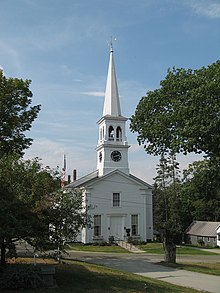
A classic New England Congregational church in Peacham, Vermont
New England has a shared heritage and culture primarily shaped by waves of immigration from Europe.[134] In contrast to other American regions, many of New England's earliest Puritan settlers came from eastern England, contributing to New England's distinctive accents, foods, customs, and social structures.[135]:30–50 Within modern New England a cultural divide exists between urban New Englanders living along the densely populated coastline, and rural New Englanders in western Massachusetts, northwestern and northeastern Connecticut, Vermont, New Hampshire, and Maine, where population density is low.[136]
Today, New England is the least religious region of the U.S. In 2009, less than half of those polled in Maine, Massachusetts, New Hampshire, and Vermont claimed that religion was an important part of their daily lives. In Connecticut and Rhode Island, also among the ten least religious states, 55 and 53%, respectively, of those polled claimed that it was.[137] According to the American Religious Identification Survey, 34% of Vermonters, a plurality, claimed to have no religion; on average, nearly one out of every four New Englanders identifies as having no religion, more than in any other part of the U.S.[138] New England had one of the highest percentages of Catholics in the U.S. This number declined from 50% in 1990 to 36% in 2008.[138]
Cultural roots
Many of the first European colonists of New England had a maritime orientation toward whaling (first noted about 1650)[139] and fishing, in addition to farming. New England has developed a distinct cuisine, dialect, architecture, and government. New England cuisine has a reputation for its emphasis on seafood and dairy; clam chowder, lobster, and other products of the sea are among some of the region's most popular foods.
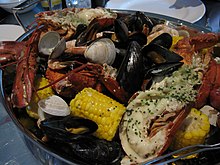
New England clam bake
New England has largely preserved its regional character, especially in its historic places. The region has become more ethnically diverse, having seen waves of immigration from Ireland, Quebec, Italy, Portugal, Germany, Poland, Scandinavia, Asia, Latin America, Africa, other parts of the U.S., and elsewhere. The enduring European influence can be seen in the region in the use of traffic rotaries, the bilingual French and English towns of northern Vermont, Maine, and New Hampshire, the region's heavy prevalence of English town- and county-names, and its unique, often non-rhotic coastal dialect reminiscent of southeastern England.
Within New England, many names of towns (and a few counties) repeat from state to state, primarily due to settlers throughout the region having named their new towns after their old ones. For example, the town of North Yarmouth, Maine was named by settlers from Yarmouth, Massachusetts, which was in turn named for Great Yarmouth in England. As another example, every New England state has a town named Warren, and every state except Rhode Island has a city or town named Andover, Bridgewater, Chester, Franklin, Manchester, Plymouth, Washington, and Windsor; in addition, every state except Connecticut has a Lincoln and a Richmond, and Massachusetts, Vermont, and Maine each contains a Franklin County.
Accents
There are several American English accents spoken in the region (normally north of Connecticut), including New England English and its derivative known as the Boston accent,[140] which is native to the northeastern coastal regions of New England. The most identifiable features of the Boston accent are believed[by whom?] to have originated from England's Received Pronunciation, which shares features such as dropping the final R and the broad A. Another source was 17th century speech in East Anglia and Lincolnshire where many of the Puritan immigrants originated.[citation needed] The East Anglian "whine" developed into the Yankee "twang".[135] Boston accents were most strongly associated at one point with the so-called "Eastern Establishment" and Boston's upper class, although today the accent is predominantly associated with blue-collar natives, as exemplified by movies such as Good Will Hunting and The Departed. The Boston accent and those accents closely related to it cover eastern Massachusetts, New Hampshire, and Maine.[141]
Some Rhode Islanders speak with a non-rhotic accent that many compare to a "Brooklyn" accent or a cross between a New York and Boston accent, where "water" becomes "wata". Many Rhode Islanders distinguish the aw sound [ɔː], as one might hear in New Jersey; e.g., the word "coffee" is pronounced /ˈkɔːfi/ KAW-fee.[142] This type of accent was brought to the region by early settlers from eastern England in the Puritan migration in the mid-seventeenth century.[135]:13–207
Social activities and music
Acadian and Québécois culture are included in music and dance in much of rural New England, particularly Maine. Contra dancing and country square dancing are popular throughout New England, usually backed by live Irish, Acadian, or other folk music. Fife and drum corps are common, especially in southern New England and more specifically Connecticut, with music of mostly Celtic, English, and local origin.

Opera houses and theaters are popular in New England towns, such as the Vergennes Opera House in Vergennes, Vermont.
Traditional knitting, quilting, and rug hooking circles in rural New England have become less common; church, sports, and town government are more typical social activities. These traditional gatherings are often hosted in individual homes or civic centers.
New England leads the U.S. in ice cream consumption per capita.[143][144] In the U.S., candlepin bowling is essentially confined to New England, where it was invented in the 19th century.[145]
New England was an important center of American classical music for some time. Prominent modernist composers also come from the region, including Charles Ives and John Adams. Boston is the site of the New England Conservatory and the Boston Symphony Orchestra.
In popular music, the region has produced Donna Summer, JoJo, New Edition, Bobby Brown, Passion Pit, Meghan Trainor, New Kids on the Block, Rachel Platten, and John Mayer. In rock music, the region has produced Rob Zombie, Aerosmith, The Modern Lovers, Phish, the Pixies, Grace Potter, GG Allin, the Dropkick Murphys, and Boston. Quincy, Massachusetts native Dick Dale helped popularize surf rock.
Media
The leading U.S. cable TV sports broadcaster ESPN is headquartered in Bristol, Connecticut. New England has several regional cable networks, including New England Cable News (NECN) and the New England Sports Network (NESN). New England Cable News is the largest regional 24-hour cable news network in the U.S., broadcasting to more than 3.2 million homes in all of the New England states. Its studios are located in Newton, Massachusetts, outside of Boston, and it maintains bureaus in Manchester, New Hampshire; Hartford, Connecticut; Worcester, Massachusetts; Portland, Maine; and Burlington, Vermont.[146] In Connecticut, Litchfield, Fairfield, and New Haven counties it also broadcasts New York based news programs—this is due in part to the immense influence New York has on this region's economy and culture, and also to give Connecticut broadcasters the ability to compete with overlapping media coverage from New York-area broadcasters.
NESN broadcasts the Boston Red Sox baseball and Boston Bruins hockey throughout the region, save for Fairfield County, Connecticut.[147] Southern Rhode Island and most of Connecticut, save for Windham County in the state's northeast corner, receive the YES Network, which broadcasts the games of the New York Yankees. For the most part, the same areas also carry SportsNet New York (SNY), which broadcasts New York Mets games.
Comcast SportsNet New England broadcasts the games of the Boston Celtics, New England Revolution and Boston Cannons.
While most New England cities have daily newspapers, The Boston Globe and The New York Times are distributed widely throughout the region. Major newspapers also include The Providence Journal, Portland Press Herald, and Hartford Courant, the oldest continuously published newspaper in the U.S.[148]
Comedy
New Englanders are well represented in American comedy. Writers for The Simpsons and late-night television programs often come by way of the Harvard Lampoon. Family Guy is an animated sitcom situated in Rhode Island, created by Connecticut native and Rhode Island School of Design graduate Seth MacFarlane (along with American Dad! and The Cleveland Show). A number of Saturday Night Live (SNL) cast members have roots in New England, from Adam Sandler to Amy Poehler, who also starred in the NBC television series Parks and Recreation. Former Daily Show correspondents John Hodgman, Rob Corddry and Steve Carell are from Massachusetts. Carell was also involved in film and the American adaptation of The Office, which features Dunder-Mifflin branches set in Stamford, Connecticut and Nashua, New Hampshire.
Late-night television hosts Jay Leno and Conan O'Brien have roots in the Boston area. Notable stand-up comedians are also from the region, including Bill Burr, Steve Sweeney, Steven Wright, Sarah Silverman, Lisa Lampanelli, Denis Leary, Lenny Clarke, Patrice O'Neal, and Louis CK. SNL cast member Seth Meyers once attributed the region's imprint on American humor to its "sort of wry New England sense of pointing out anyone who's trying to make a big deal of himself", with the Boston Globe suggesting that irony and sarcasm are its trademarks, as well as Irish influences.[149]
Literature

Ralph Waldo Emerson was born in Boston and spent most of his literary career in Concord, Massachusetts.
The literature of New England has had an enduring influence on American literature in general, with themes that are emblematic of the larger concerns of American letters, such as religion, race, the individual versus society, social repression, and nature.[150] Famous New England writers include Transcendentalist philosophers Ralph Waldo Emerson and Henry David Thoreau, poets Emily Dickinson and Elizabeth Bishop, and novelists Nathaniel Hawthorne and Harriet Beecher Stowe.
Boston was the center of the American publishing industry for some years, largely on the strength of its local writers and before it was overtaken by New York in the middle of the nineteenth century. Boston remains the home of publishers Houghton Mifflin and Pearson Education, and it was the longtime home of literary magazine The Atlantic Monthly. Merriam-Webster is based in Springfield, Massachusetts. Yankee is a magazine for New Englanders based in Dublin, New Hampshire.
Twentieth and twenty-first century writers hailing from New England include Maine native Stephen King and New Hampshire native John Irving, and New England is a major setting of their works. George V. Higgins wrote about life in the New England criminal underworld, while H.P. Lovecraft set many of his works of horror in his native Rhode Island.
Film, television, and acting
New England has a rich history in filmmaking dating back to the dawn of the motion picture era at the turn of the 20th century, sometimes dubbed Hollywood East by film critics. A theater at 547 Washington Street in Boston was the second location to debut a picture projected by the Vitascope, and shortly thereafter several novels were being adapted for the screen and set in New England, including The Scarlet Letter and The House of Seven Gables.[151] The New England region continued to churn out films at a pace above the national average for the duration of the 20th century, including blockbuster hits such as Jaws, Good Will Hunting, and The Departed, all of which won Academy Awards. The New England area became known for a number of themes that recurred in films made during this era, including the development of yankee characters, smalltown life contrasted with city values, seafaring tales, family secrets, and haunted New England.[152] These themes are rooted in centuries of New England culture and are complemented by the region's diverse natural landscape and architecture, from the Atlantic Ocean and brilliant fall foliage to church steeples and skyscrapers.
Since the turn of the millennium, Boston and the greater New England region have been home to the production of numerous films and television series, thanks in part to tax incentive programs put in place by local governments to attract filmmakers to the region.[153]
Notable actors and actresses that have come from the New England area include Ben Affleck, Matt Damon, Amy Poehler, Elizabeth Banks, Steve Carell, Ruth Gordon, John Krasinski, Edward Norton, Mark Wahlberg, and Matthew Perry. A full list of those from Massachusetts can be found here, and a listing of notable films and television series produced in the area here.
Sports
Boston Marathon
Two popular American sports were invented in New England: basketball, invented by James Naismith (a Canadian) in Springfield, Massachusetts, in 1891,[154] and volleyball, invented in 1895 by William G. Morgan, in Holyoke, Massachusetts.[155] Additionally, Walter Camp is credited with developing modern American football in New Haven, Connecticut, in the 1870s and 1880s.[156]
New Hampshire Motor Speedway is an oval racetrack that has hosted several NASCAR and American Championship Car Racing races, whereas Lime Rock Park in Connecticut is a traditional road racing venue home of sports car races. Events at these venues have had the "New England" moniker, such as the NASCAR New England 300 and New England 200, the IndyCar Series New England Indy 200, and the American Le Mans Series New England Grand Prix.
Professional and semi-professional sports teams
The major professional sports teams in New England are based in Massachusetts: the Boston Red Sox, the New England Patriots (based in Foxborough, Massachusetts), the Boston Celtics, the Boston Bruins, the New England Revolution (also based in Foxborough), and the Boston Cannons. Hartford had a professional hockey team, the Hartford Whalers, from 1975 until they moved to North Carolina in 1997. WNBA team the Connecticut Sun is based in southeastern Connecticut at the Mohegan Sun resort, which is also home to the professional indoor lacrosse team the New England Black Wolves. New England is also home to the Worcester Blades, Boston Pride, and the Connecticut Whale which represent three of the five professional women's hockey teams in the United States.
There are also minor league baseball and hockey teams based in larger cities, such as the Bridgeport Bluefish (baseball), the Bridgeport Sound Tigers (hockey), the Connecticut Tigers (baseball), the Hartford Yard Goats (baseball), the Hartford Wolf Pack (hockey), the Lowell Spinners (baseball), the Manchester Monarchs (hockey), the New Britain Bees (baseball), the New Hampshire Fisher Cats (baseball), the Pawtucket Red Sox (baseball), the Portland Sea Dogs (baseball), the Providence Bruins (hockey), the Springfield Thunderbirds (hockey), the Vermont Lake Monsters (baseball), the Worcester Railers (hockey), and the Maine Mariners (hockey).
The NBA G League fields the Maine Red Claws based in Portland, Maine. The Springfield Armor in Springfield, Massachusetts previously played in the region. The Red Claws are affiliated with the Boston Celtics, and the Armor was affiliated with the Brooklyn Nets, prior to relocating to Grand Rapids, Michigan to become the Grand Rapids Drive. New England was also represented in the Premier Basketball League by the Vermont Frost Heaves of Barre, Vermont until they folded in 2011.
Thanksgiving Day high school football rivalries date back to the 19th century, and the Harvard-Yale rivalry ("The Game") is the oldest rivalry in college football. The Boston Marathon is run on Patriots' Day every year; it is a New England cultural institution and the oldest annual marathon in the world. The race offers far less prize money than many other marathons, but its difficulty and long history make it one of the world's most prestigious marathons.[157]
TD Garden
Fenway Park

Gillette Stadium

Hadlock Field

McCoy Stadium

Harvard Stadium
Transportation

The MBTA Commuter Rail serves much of Massachusetts and parts of Rhode Island radiating from Downtown Boston, with plans for expansion into New Hampshire.[158][159]
The Massachusetts Bay Transportation Authority (MBTA) provides rail and subway service within the Boston metropolitan area, bus service in Greater Boston, and commuter rail service throughout Eastern Massachusetts and parts of Rhode Island. The New York City Metropolitan Transportation Authority in partnership with the Connecticut Department of Transportation (CTDOT) operates the Metro-North Railroad, which provides commuter rail service in Southwestern Connecticut in the corridor between New York City and New Haven. CTDOT provides the Shore Line East commuter rail service along the Connecticut coastline east of New Haven, terminating in Old Saybrook and New London.
Amtrak provides interstate rail service throughout New England. Boston is the northern terminus of the Northeast Corridor. The Vermonter connects Vermont to Massachusetts and Connecticut, while the Downeaster links Maine to Boston. The long-distance Lake Shore Limited train has two eastern termini after splitting in Albany, one of which is Boston. This provides rail service on the former Boston and Albany Railroad, which runs between its namesake cities. The rest of the Lake Shore Limited continues to New York City.
See also
- Autumn in New England
- Brother Jonathan
- Extreme points of New England
- Fieldstone
- Historic New England
- List of beaches in New England
- List of mammals of New England
- Manor of East Greenwich
- New Albion
- New Albion (colony)
- New England/Acadian forests
- New England Confederation
- New England Planters
- New England Summer Nationals
- Northeastern coastal forests
Southeastern New England AVA wine region- Swamp Yankee
Notes
^ [4][5][6][7][8][9]
References
^ "Resident Population in the New England Census Division". US Census Bureau. Retrieved May 29, 2014..mw-parser-output cite.citationfont-style:inherit.mw-parser-output .citation qquotes:"""""""'""'".mw-parser-output .citation .cs1-lock-free abackground:url("//upload.wikimedia.org/wikipedia/commons/thumb/6/65/Lock-green.svg/9px-Lock-green.svg.png")no-repeat;background-position:right .1em center.mw-parser-output .citation .cs1-lock-limited a,.mw-parser-output .citation .cs1-lock-registration abackground:url("//upload.wikimedia.org/wikipedia/commons/thumb/d/d6/Lock-gray-alt-2.svg/9px-Lock-gray-alt-2.svg.png")no-repeat;background-position:right .1em center.mw-parser-output .citation .cs1-lock-subscription abackground:url("//upload.wikimedia.org/wikipedia/commons/thumb/a/aa/Lock-red-alt-2.svg/9px-Lock-red-alt-2.svg.png")no-repeat;background-position:right .1em center.mw-parser-output .cs1-subscription,.mw-parser-output .cs1-registrationcolor:#555.mw-parser-output .cs1-subscription span,.mw-parser-output .cs1-registration spanborder-bottom:1px dotted;cursor:help.mw-parser-output .cs1-ws-icon abackground:url("//upload.wikimedia.org/wikipedia/commons/thumb/4/4c/Wikisource-logo.svg/12px-Wikisource-logo.svg.png")no-repeat;background-position:right .1em center.mw-parser-output code.cs1-codecolor:inherit;background:inherit;border:inherit;padding:inherit.mw-parser-output .cs1-hidden-errordisplay:none;font-size:100%.mw-parser-output .cs1-visible-errorfont-size:100%.mw-parser-output .cs1-maintdisplay:none;color:#33aa33;margin-left:0.3em.mw-parser-output .cs1-subscription,.mw-parser-output .cs1-registration,.mw-parser-output .cs1-formatfont-size:95%.mw-parser-output .cs1-kern-left,.mw-parser-output .cs1-kern-wl-leftpadding-left:0.2em.mw-parser-output .cs1-kern-right,.mw-parser-output .cs1-kern-wl-rightpadding-right:0.2em
^ "Yankee". The American Heritage Dictionary. Boston: Houghton Mifflin Company. 2000. Retrieved March 28, 2011.
^ "Gross domestic product (GDP) by state (millions of current dollars)" (PDF). U.S. Department of Commerce. Bureau of Economic Analysis. Retrieved December 14, 2015.
^ "Columbia Electronic Encyclopedia". Encyclopedia2.thefreedictionary.com. Retrieved October 16, 2010.
^ ab "Britannica article". Encyclopædia Britannica. Retrieved October 16, 2010.
^ "American Heritage Dictionary". Houghton Mifflin Harcourt. Retrieved August 17, 2016.
^ "Random House Unabridged Dictionary". Dictionary.infoplease.com. Retrieved October 16, 2010.
^ "Merriam-Webster Dictionary". Merriam-webster.com. August 13, 2010. Retrieved October 16, 2010.
^ "New England". Microsoft Encarta Online Encyclopedia 2003. Archived copy. Archived from the original on November 1, 2003. Retrieved October 10, 2010.CS1 maint: Archived copy as title (link) CS1 maint: BOT: original-url status unknown (link)
^ "The 1692 Salem Witch Trials". SalemWitchTrialsMuseum.com. Retrieved April 21, 2015.
^ Chiu, Monica (2009). Asian Americans in New England: Culture and Community. Lebanon, NH: University of New Hampshire Press. p. 44. Retrieved October 12, 2016.
^ abcd Bain, Angela Goebel; Manring, Lynne; and Mathews, Barbara. Native Peoples in New England. Retrieved July 21, 2010, from Pocumtuck Valley Memorial Association.
^ "Abenaki History". abenakination.org. Retrieved March 28, 2011.
^ Allen, William (1849). The History of Norridgewock. Norridgewock ME: Edward J. Peet. p. 10. Retrieved March 28, 2011.
^ Wiseman, Fred M. "The Voice of the Dawn: An Autohistory of the Abenaki Nation". p. 70. Retrieved March 28, 2011.
^ "What are the oldest cities in America?". Glo-con.com. Archived from the original on September 28, 2007. Retrieved August 11, 2007.
^ Cressy, David (1987). Coming Over: Migration and Communication Between England and New England in the Seventeenth Century. p. 4. Cambridge University Press.
^ Swindler, William F., ed; Sources and Documents of United States Constitutions 10 Volumes; Dobbs Ferry, New York; Oceana Publications, 1973–1979. Volume 5: pp. 16–26.
^ "...joint stock company organized in 1620 by a charter from the British crown with authority to colonize and govern the area now known as New England." New England, Council for. (2006). In Encyclopædia Britannica. Retrieved July 13, 2006, from Encyclopædia Britannica Premium Service: Britannica.com Archived February 12, 2005, at the Wayback Machine
^ Haxtun, Anne Arnoux (1896). Signers of the Mayflower Compact, vol. 1. New York: The Mail and Express Publishing Company. Retrieved March 29, 2011.
^ Townsend, Edward Waterman (1906). Our Constitution: How and Why It Was Made. New York: Moffat, Yard & Company. p. 42. Retrieved March 29, 2011.
^ Secretary of the Commonwealth of Massachusetts. "Public Records: The History of the Arms and Great Seal of the Commonwealth of Massachusetts". sec.state.ma.us. Retrieved March 29, 2011.
^ Northend, William Dummer (1896). The Bay Colony: A Civil, Religious and Social History of the Massachusetts Colony. Boston: Estes and Lauriat. p. 305.
^ "History of Boston, Massachusetts". U-S-History.com. Retrieved August 17, 2016.
^ State of Connecticut. "About Connecticut". CT.gov. Archived from the original on April 29, 2011. Retrieved March 28, 2011.
^ Peace, Nancy E. (November 1976). "Roger Williams—A Historiographical Essay" (PDF). Rhode Island History. Providence RI: The Rhode Island Historical Society. pp. 103–115. Retrieved March 28, 2011.
^ "History & Famous Rhode Islanders". Rhode Island Tourism Division. Retrieved March 28, 2011.
^ Hall, Hiland (1868). The History of Vermont: From Its Discovery to Its Admission into the Union. Albany NY: Joel Munsell. p. 3.
^ "1637 - The Pequot War". The Society of Colonial Wars in the State of Connecticut. Retrieved December 14, 2013.
^ Howe, Daniel Wait (1899). The Puritan Republic of the Massachusetts Bay in New England. Indianapolis: Bowen-Merrill. pp. 308–311.
^ "1675 - King Philip's War". The Society of Colonial Wars in the State of Connecticut. Retrieved December 14, 2013.
^ See the French and Indian Wars as well as Father Rale's War and Father Le Loutre's War for more information.
^ Morison, Samuel Eliot (1972). The Oxford History of the American People. New York City: Mentor. p. 112. ISBN 0-451-62600-1.
^ Martucci, David B. "The New England Flag". D. Martucci. Archived from the original on April 1, 2007. Retrieved July 25, 2008.
^ "Flags of the Early North American Colonies and Explorers". Historical Flags of Our Ancestors.
^ Leepson, Marc (2007). Flag: An American Biography. New York: Thomas Dunne Books. p. 14.
^ Various (1908). Proceedings of the First New England Conference: Called by the Governors of the New England States, Boston, Nov. 23, 24, 1908. Boston: Wright & Potter Printing Company. p. 6.
^ Preble, George Henry (1880). History of the Flag of the United States of America: And of the Naval and Yacht-club Signals, Seals, and Arms, and Principal National Songs of the United States, with a Chronicle of the Symbols, Standards, Banners, and Flags of Ancient and Modern Nations. Boston: A. Williams. p. 190.
^ Stark, Bruce P. "The Dominion of New England". Connecticut Humanities Council. Retrieved March 30, 2011.
^ Palfrey, John Gorham (1865). History of New England, vol. 3. Boston: Little, Brown, and Company. pp. 561–590. Retrieved March 30, 2011.
^ Palfrey, John Gorham (1873). A Compendious History of New England, vol. 3. Boston: H.C. Shepard. Retrieved March 30, 2011.
^ Wesley Frank Craven, Colonies in Transition, 1660 – 1713 (1968). p. 224.
^ Harper, Douglas. "Slavery in New Hampshire". Slavenorth.com. Retrieved August 17, 2016.
^ "Yankeeland". The Random House Dictionary. Boston: Random House. 2013. Retrieved September 5, 2013.
^ Library of Congress. "Missouri Compromise: Primary Documents of American History". Retrieved March 30, 2011.
^ James Schouler, History of the United States, Vol. 1 (New York: Dodd, Mead & Company. 1891; copyright expired)
^ Dwight, Theodore (1833). History of the Hartford Convention. New York: N. & J. White. Retrieved March 30, 2011.
^ Hickey, Donald R. The War of 1812: A Forgotten Conflict. University of Illinois Press. p. 233.
^ Cooper, Thomas Valentine; Fenton, Hector Tyndale (1884). American Politics (Non-Partisan) from the Beginning to Date, Book III. Chicago: C. R. Brodix. pp. 64–69.
^ Cairns, William B. (1912). A History of American Literature. New York: Oxford University Press. Retrieved March 30, 2011.
^ "New England", Microsoft Encarta Online Encyclopedia 2006. Archived copy. Archived from the original on October 13, 2006. Retrieved November 22, 2009.CS1 maint: Archived copy as title (link) CS1 maint: BOT: original-url status unknown (link)
^ "History & Culture: Birthplace of the American Industrial Revolution". Blackstone River Valley National Heritage Corridor, MA, RI. National Park Service. June 11, 2009. Retrieved April 4, 2016.
^ Bagnall, William R. The Textile Industries of the United States: Including Sketches and Notices of Cotton, Woolen, Silk, and Linen Manufacturers in the Colonial Period. Vol. I. pg. 97. The Riverside Press, 1893.
^ "Forging Arms for the Nation". Springfield Armory National Historic Site, Massachusetts. National Park Service. Retrieved April 4, 2016.
^ Coen, Scott (May 13, 2011). "The Springfield Armory: The Heartbeat of the 19th Century Industrial Revolution". MassLive.com. Retrieved April 4, 2016.
^ Rooker, Sarah. "The Industrial Revolution: Connecticut River Valley Overview". Teaching the Industrial Revolution. The Flow of History. Archived from the original on March 5, 2016. Retrieved April 4, 2016.
^ Dublin, Thomas. "Lowell Millhands". Transforming Women's Work (1994) pp. 77–118.
^ ab "Census Data for Year 1850". Historical Census Browser. University of Virginia Library. Archived from the original on April 24, 2016. Retrieved April 4, 2016.
^ Wyatt-Brown, Bertram. "American Abolitionism and Religion". Divining America: Religion in American History. National Humanities Center TeacherServe. Retrieved April 4, 2016.
^ ab Tarr, David; Benenson, Bon (2012). Elections A to Z. Thousand Oaks, CA: CQ Press. p. 542. ISBN 978-0-87289-769-4. Retrieved April 19, 2015.
^ Minchin, Timothy J. (2013). "The Crompton Closing: Imports and the Decline of America's Oldest Textile Company". Journal of American Studies. 47 (1): 231–260.
^ Henry Etzkowitz, MIT and the Rise of Entrepreneurial Science (Routledge 2007)
^ David Koistinen, Confronting Decline: The Political Economy of Deindustrialization in Twentieth-Century New England (2013)
^ Bishaw, Alemayehu; Iceland, John (May 2003). "Poverty: 1999" (PDF). Census 2000 Brief. US Census Bureau. Retrieved August 17, 2016.
^ "Income in the Past 12 Months (in 2014 Inflation-Adjusted Dollars): 2014 American Community Survey 1-Year Estimates (S1901)". American Factfinder. United States Census Bureau. Retrieved April 4, 2016.
^ "Part 1: Population and Housing Unit Counts" (PDF). 2000 Census of Population and Housing – United States Summary: 2000. United States Census Bureau. April 2004. Retrieved April 4, 2016.
^ "The British Isles and all that ..." Heriot-Watt University, Edinburgh. Retrieved March 7, 2011.
^ "Glacial Features of the Exotic Terrane". The Teacher-Friendly Guide to the Earth Science of the Northeastern US. Paleontological Research Institution. Retrieved April 4, 2016.
^ abcd Emerson, Philip (1922). The Geography of New England. New York: The Macmillan Company. Retrieved March 28, 2011.
^ "Physiographic divisions of the conterminous U.S." U.S. Geological Survey. Retrieved December 23, 2011.
^ "Topography of the Appalachian/Piedmont Region 2". The Teacher-Friendly Guide to the Earth Science of the Northeastern US. Paleontological Research Institution. Retrieved April 4, 2016.
^ Shaw, Ethan. "The 10 Tallest Mountains East of the Mississippi". USA Today. Retrieved April 4, 2016.
^ "World Record Wind". Mount Washington Observatory. Retrieved April 4, 2016.
^ "World Record Wind Gust: 408 km/h". World Meteorological Organization. January 22, 2010. Archived from the original on July 22, 2011. Retrieved May 27, 2011.
^ "About Us". Mount Washington Observatory. Retrieved April 4, 2016.
^ Hrin, Eric (March 26, 2011). "Wolfe turns love of books into career; One-hundredth anniversary of library in Troy approaching". The Daily Review. Towanda, PA. Archived from the original on July 30, 2012. Retrieved May 28, 2011.
^ "New England's Fall Foliage". Discover New England. Archived from the original on August 16, 2007. Retrieved May 28, 2011.
^ ab "New England Population: 2010 Census" (PDF). Rhode Island Department of Labor and Training. Retrieved December 15, 2013.
^ "Population Estimates".
[permanent dead link]
^ Martin, Joyce A.; Hamilton, Brady E.; Sutton, Paul D.; Ventura, Stephanie J.; Mathews, T.J.; Osterman, Michelle J.K. (December 8, 2010). "Births: Final Data for 2008" (PDF). National Vital Statistics Reports. 59 (1). Retrieved April 4, 2016.
^ ab "Hispanic or Latino Origin by Specific Origin: 2014 American Community Survey 1-Year Estimates: New England Division (B03001)". American Factfinder. U.S. Census Bureau. Retrieved April 4, 2016.
^ "People Reporting Ancestry: 2014 American Community Survey 1-Year Estimates: New England Division (B04006)". American Factfinder. U.S. Census Bureau. Retrieved April 4, 2016.
^ Includes English and "British" but not Scottish or Welsh.
^ Toronto, Anthony (January 1, 2019). "Most Common Languages Besides English In The US & New England". Interpreters and Translators, Inc.
^ ab "Language Spoken at Home: 2014 American Community Survey 1-Year Estimates: New England Division (S1601)". American Factfinder. U.S. Census Bureau. Retrieved April 4, 2016.
^ "Language Spoken at Home by Ability to Speak English for the Population 5 Years and Over: 2014 American Community Survey 1-Year Estimates: New England Division (B16001)". American Factfinder. U.S. Census Bureau. Retrieved April 4, 2016.
^ "Selected Characteristics of the Native and Foreign-Born Populations: 2014 American Community Survey 1-Year Estimates: New England Division (S0501)". American Factfinder. U.S. Census Bureau. Retrieved April 4, 2016.
^ "Place of Birth for the Foreign-Born Population in the United States: 2014 American Community Survey 1-Year Estimates: New England Division (B05006)". American Factfinder. U.S. Census Bureau. Retrieved April 4, 2016.
^ ab "Annual Estimates of the Resident Population: April 1, 2010 to July 1, 2015 - United States -- Metropolitan and Micropolitan Statistical Area: 2015 Population Estimates (GCT-PEPANNRES)". American Factfinder. U.S. Census Bureau. Retrieved April 4, 2016.
^ "Annual Estimates of the Resident Population: April 1, 2010 to July 1, 2015 - United States -- Combined Statistical Area: 2015 Population Estimates (GCT-PEPANNRES)". American Factfinder. U.S. Census Bureau. Retrieved April 4, 2016.
^ "Annual Estimates of the Resident Population for Incorporated Places: April 1, 2010 to July 1, 2014". U.S. Census Bureau. Archived from the original on May 22, 2015. Retrieved April 4, 2016.
^ "TIGERweb". U.S. Census Bureau. (Combined Statistical Areas checkbox). Retrieved April 4, 2016.
^ "Background on the New England Economy". U.S. Department of Commerce. Archived from the original on September 19, 2002.
^ "Regional Data: GDP & Personal Income". Bureau of Economic Analysis. U.S. Department of Commerce. Retrieved September 21, 2014.
^ Rich, Jack C. (1988). Materials and Methods of Sculpture. Dover Publications.
^ "The Global Financial Centres Index 21" (PDF). Long Finance. March 2017. Archived from the original (PDF) on June 11, 2017.
^ Yeandle, Mark (March 2011). "The Global Financial Centres Index 9" (PDF). The Z/Yen Group. p. 4. Archived from the original (PDF) on October 14, 2012. Retrieved January 31, 2013.
^ "Top 10 Cities For A Career In Finance". Investopedia.com. Retrieved May 13, 2010.
^ "History of Boston's Economy – Growth and Transition 1970–1998" (PDF). Boston Redevelopment Authority. November 1999. p. 9. Archived from the original (PDF) on July 23, 2013. Retrieved March 12, 2013.
^ Morris, Marie (2006). Frommer's Boston 2007 (2 ed.). John Wiley & Sons. p. 59. ISBN 978-0-470-08401-4.
^ "General Electric To Move Corporate Headquarters To Boston". CBS Local Media. January 13, 2016. Retrieved January 15, 2016.
^ "Top shoe brands, like Reebok and Converse, move headquarters to Boston". Omaha.com. Retrieved January 19, 2017.
^ "Reebok Is Moving to Boston". Boston Magazine. Retrieved January 19, 2017.
^ STAFF, COURANT. "Connecticut Has 19 Companies On Fortune 500 List". courant.com. Retrieved May 19, 2017.
^ "Maine State Agriculture Overview - 2004" (PDF). USDA National Agricultural Statistics Service. Archived from the original (PDF) on March 5, 2006.
^ "Vermont State Agriculture Overview - 2006" (PDF). USDA National Agricultural Statistics Service. Archived from the original (PDF) on July 22, 2006.
^ "Connecticut State Agriculture Overview - 2005" (PDF). USDA National Agricultural Statistics Service. Archived from the original (PDF) on November 1, 2006. Retrieved November 14, 2006.
^ "Massachusetts State Agriculture Overview - 2005" (PDF). USDA National Agricultural Statistics Service. Archived from the original (PDF) on November 10, 2006. Retrieved November 14, 2006.
^ U.S. Department of Energy. "State Energy Profiles: State Rankings - State Ranking 7. Total Energy Consumed per Capita, 2013 (million Btu)". Retrieved April 4, 2016.
^ U.S. Department of Energy. "State Energy Profiles: State Rankings - State Ranking 9. Average Retail Price of Electricity to Residential Sector, December 2015 (cents/kWh)". Retrieved April 4, 2016.
^ "National Conference of State Legislatures State Unemployment Rates 2015" (PDF). National Conference of State Legislatures. Retrieved February 24, 2017.
^ "Unemployment Rates for States". Bureau of Labor Statistics. United States Government. Retrieved March 17, 2015.
^ "New England — Labor Force Statistics". U.S. Department of Labor. Retrieved December 18, 2011.
^ McCann, Adam. "2018's Tax Burden by State". WalletHub.
^ De Tocqueville, Alexis. Democracy in America. Quotation attributed at [1] . Retrieved July 20, 2010.
^
Madison, James. Federalist No. 55. Quotation attributed at Ilsr.org[permanent dead link]Archive index at the Wayback Machine. Retrieved July 19, 2006.
^ See Harvard lecturer Robert I. Rotberg review Real Democracy: the New England town meeting and how it works at Democraciaparticipativa.net (Retrieved July 19, 2006) (in Spanish), (in English). Archived September 28, 2007, at the Wayback Machine
^ "New England USA Quick Facts". Discover New England. Archived from the original on August 12, 2015. Retrieved April 4, 2016.
^ "Wyoming, Mississippi, Utah Rank as Most Conservative States". Gallup.com. Retrieved December 31, 2013.
^ "Election Center 2008". CNN. Retrieved October 4, 2008.
^ Salzman, Avi (December 18, 2005). "A Laboratory for Liberals?". New York Times. Retrieved April 4, 2016.
^ "New England grapples with first execution". Concord Monitor. May 13, 2005. Archived from the original on May 15, 2011. Retrieved July 20, 2010.
^ Grynbaum, Michael M. (June 8, 2006). "Gregg cites states' rights in voting against amendment". Boston Globe. Retrieved April 4, 2016.
^ Jones, Jeffrey M. (February 4, 2015). "Massachusetts, Maryland Most Democratic States". Gallup. Retrieved April 4, 2016.
^ Kazin, Michael; Edwards, Rebecca; Rothman, Adam (2011). The Concise Princeton Encyclopedia of American Political History. Princeton University Press. pp. 360–365.
^ Purple, Matt (April 1, 2010). "No More 'New England Republicans'". The American Spectator. Retrieved April 4, 2016.
^ "Mike Huckabee: Mike Huckabee's Weekly Schedule for Sept. 24". All American Patriots website. September 25, 2007. Archived from the original on March 21, 2012. Retrieved March 21, 2012.
^ Muther, Christopher (July 1, 2010). "Prepping for a party". The Boston Globe. Retrieved April 4, 2016.
^ "Boston Latin School". Encyclopædia Britannica Online.
^ Varhola, Michael (2011). Life in Civil War America. F+W Media. ISBN 9781440310881. Retrieved June 22, 2012.
^ "FRBB: New England Economic Review". Federal Reserve Bank of Boston. Retrieved July 25, 2008.
^ McWilliams, John P. (2004). New England's Crises and Cultural Memory. Cambridge: Cambridge University Press. Retrieved April 4, 2016.
^ abc Fischer, David Hackett (1991). Albion's Seed: Four British Folkways in America. Oxford University Press US. ISBN 0195069056. Retrieved April 4, 2016.
^ "New England Population History". Brown University. Archived from the original on September 5, 2008. Retrieved August 26, 2008.
^ Newport, Frank (January 28, 2009). "State of the States: Importance of Religion". Gallup. Retrieved April 4, 2016.
^ ab Kosmin, Barry A.; Keysar, Ariela (March 2009). "ARIS 2008 Report: Part IIIC – Geography and Religion" (PDF). American Religious Identification Survey. Retrieved April 4, 2016.
^
Starbuck, Alexander (1878). History of the American Whale Fishery from its Earliest Inception to the Year 1876. Waltham, Mass.: Alexander Starbuck. Retrieved October 8, 2014.
^ "Common Traits of the Boston Accent". Boston.com. Retrieved January 3, 2018.
^ Metcalf, Allan. How We Talk: American Regional English Today. Houghton Mifflin.
^ "Guide to Rhode Island Language Stuff". Quahog.org. Retrieved May 30, 2007.
^ Nelson, Jennifer (April 27, 2007). "New England's best ice cream". The Boston Globe. Archived from the original on July 18, 2008. Retrieved January 14, 2008.
^ "Surviving the New England Winter: You Scream, I Scream, Ice Cream!". The Harvard Harbus. December 5, 2005. Retrieved April 4, 2016.
^ "History of Candlepin Bowling". Massachusetts Bowling Association. Archived from the original on August 26, 2007. Retrieved August 23, 2007.
^ New England Cable News. Available at Boston.com Archived December 16, 2013, at the Wayback Machine. Retrieved July 19, 2006.
^ New England Sports Network, Archived at: "Boston.com". Archived from the original on November 7, 2005. Retrieved November 7, 2005.CS1 maint: BOT: original-url status unknown (link), Retrieved July 19, 2006
^ "Older Than the Nation". Hartford Courant. Retrieved April 4, 2016.
^ Page, Janice (January 25, 2004). "What's So Funny?". Boston.com. Retrieved January 27, 2010.
^ Gates, David (June 29, 2006). "Destination: New England". Salon. Retrieved April 4, 2016.
^ Kharfen, Stephen. "A History of Boston Films" (PDF). Retrieved February 24, 2014.
^ Sheldon, Karan. "New England in Feature Films". Retrieved February 24, 2014.
^ Rotella, Carlo. "Hollywood on the Charles: Why the movie industry is crazy for Boston". Boston Magazine. Archived from the original on January 6, 2014. Retrieved December 13, 2013.
^ Mary Bellis. "History of Basketball". About.com. Retrieved October 28, 2008.
^ "History of Volleyball". Volleyball World Wide. Retrieved October 28, 2008.
^ "Ohio Tiger Trap" (PDF). Archived from the original (PDF) on June 13, 2010. Retrieved October 16, 2010.
^ "In marathoning, it has a foothold – History means Boston can give any race in the world a run for its money" by John Powers, The Boston Globe, April 10, 2005
^ "Haverhill chamber chief supports train stop in Plaistow". Eagletribune.com. Archived from the original on January 22, 2013. Retrieved November 11, 2012.
^ "Plaistow officials hopeful MBTA considers rail extension". Eagletribune.com. March 9, 2008. Archived from the original on July 29, 2012. Retrieved November 11, 2012.
Bibliography
New York: Atlas of Historical County Boundaries, John H. Long, Editor; Compiled by Kathryn Ford Thorne; A Project of the Dr. William M. Scholl Center for Family and Community History, The new Berry Library, Simon & Schuster, 1993- U.S. Census Bureau, ""Census Regions and Divisions of the United States"" (PDF). Archived from the original (PDF) on January 7, 2013. (1.06 MB)
Further reading
- Hall, Donald, Burt Feintuch, and David H. Watters, eds. Encyclopedia of New England (Yale U.P. 2005), 1596 pp; the major scholarly resource to the geography, history and culture of the region.
ISBN 0-300-10027-2 - Bartlett, Ray et al. New England Trips.
ISBN 1-74179-728-4 - Berman, Eleanor. Eyewitness Travel Guides New England.
ISBN 0-7566-2697-8 - Chenoweth, James. Oddity Odyssey: A Journey Through New England's Colorful Past. Holt, 1996. Humorous travel guide.
ISBN 0-8050-3671-7 - Koistinen, David. Confronting Decline: The Political Economy of Deindustrialization in Twentieth-Century New England (2013)
- Muse, Vance. The Smithsonian Guide to Historic America: Northern New England. Stewart, Tabori & Chang, 1998. A photographic guide to historic sites in New England.
ISBN 1-55670-635-9 - Riess, Jana. The Spiritual Traveler Boston and New England: A Guide to Sacred Sites and Peaceful Places, HiddenSpring
ISBN 1-58768-008-4 - Sletcher, Michael. New England: The Greenwood Encyclopedia of American Regional Cultures (2004)
- Wiencek, Henry. The Smithsonian Guide to Historic America: Southern New England. Stewart, Tabori & Chang, 1998. A photographic guide to historic sites in New England.
ISBN 1-55670-633-2
External links
- Political
- New England Governors Conference
- Historic
- Historic New England
Minuteman National Park Homepage - American Revolution battle site
- Maps
- Historic USGS Maps of New England & NY
Map of New England. From the 1871 Atlas of Massachusetts by Walling and Gray.
- Culture
- New England Music Archive
Coordinates: 44°N 71°W / 44°N 71°W / 44; -71
.mw-parser-output .subjectbarbackground-color:#f9f9f9;border:1px solid #aaa;clear:both;margin-bottom:0.5em;margin-top:0.5em;width:100%;box-sizing:border-box;font-size:88%
Categories:
- English colonization of the Americas
- New England
- Census regions of the United States
- Military history of New England
- History of New England
- Regions of the United States
(window.RLQ=window.RLQ||[]).push(function()mw.config.set("wgPageParseReport":"limitreport":"cputime":"2.752","walltime":"3.420","ppvisitednodes":"value":16970,"limit":1000000,"ppgeneratednodes":"value":0,"limit":1500000,"postexpandincludesize":"value":853086,"limit":2097152,"templateargumentsize":"value":78074,"limit":2097152,"expansiondepth":"value":26,"limit":40,"expensivefunctioncount":"value":36,"limit":500,"unstrip-depth":"value":1,"limit":20,"unstrip-size":"value":462199,"limit":5000000,"entityaccesscount":"value":1,"limit":400,"timingprofile":["100.00% 2326.446 1 -total"," 46.15% 1073.704 2 Template:Reflist"," 22.83% 531.166 100 Template:Cite_web"," 13.27% 308.629 1 Template:Infobox_settlement"," 10.60% 246.594 25 Template:Navbox"," 8.44% 196.256 1 Template:Infobox"," 6.87% 159.749 1 Template:Es_icon"," 6.86% 159.576 2 Template:Link_language"," 5.93% 138.014 27 Template:Cite_book"," 3.21% 74.787 1 Template:Regions_of_the_world"],"scribunto":"limitreport-timeusage":"value":"1.172","limit":"10.000","limitreport-memusage":"value":30950484,"limit":52428800,"cachereport":"origin":"mw1290","timestamp":"20190423160950","ttl":2592000,"transientcontent":false);mw.config.set("wgBackendResponseTime":140,"wgHostname":"mw1321"););















